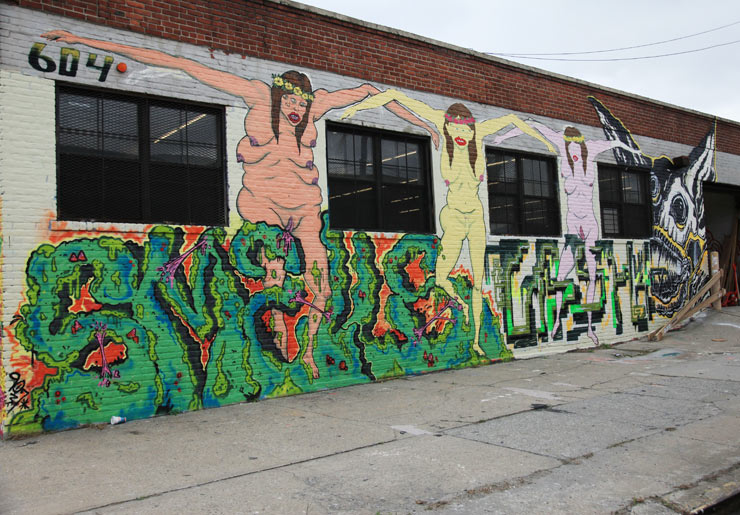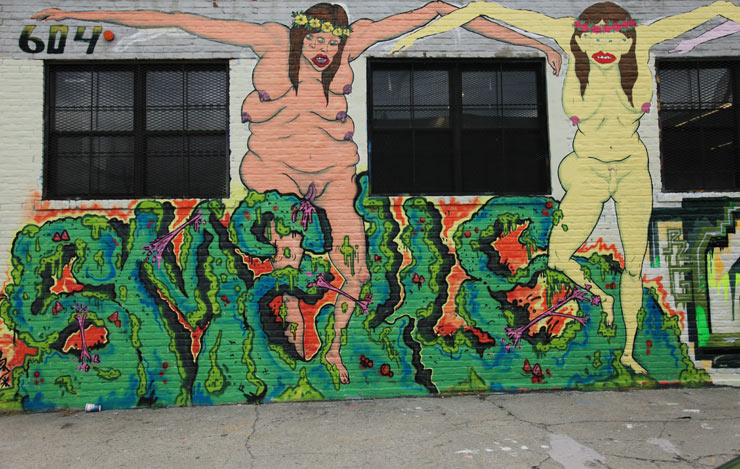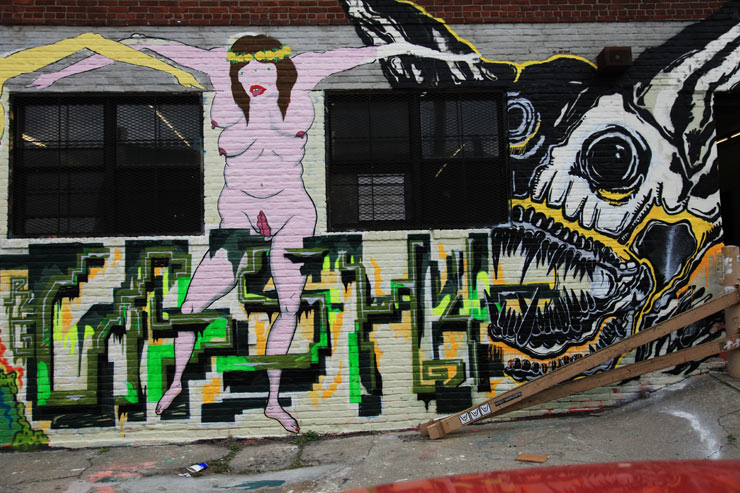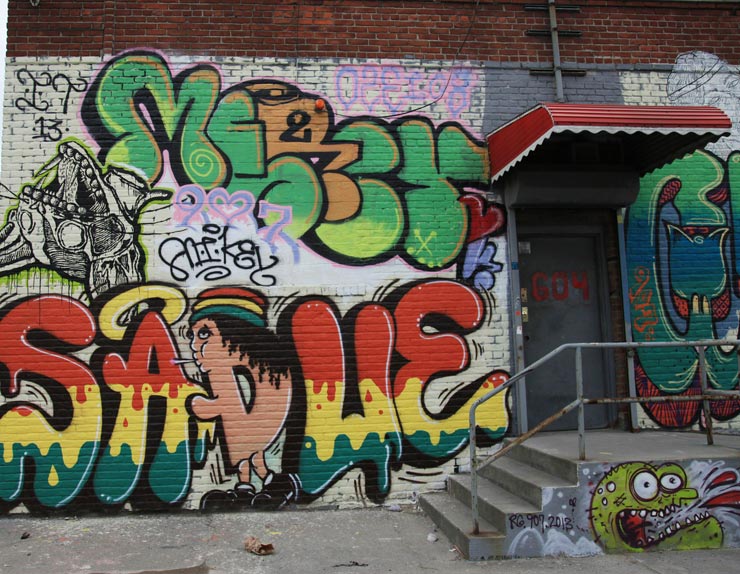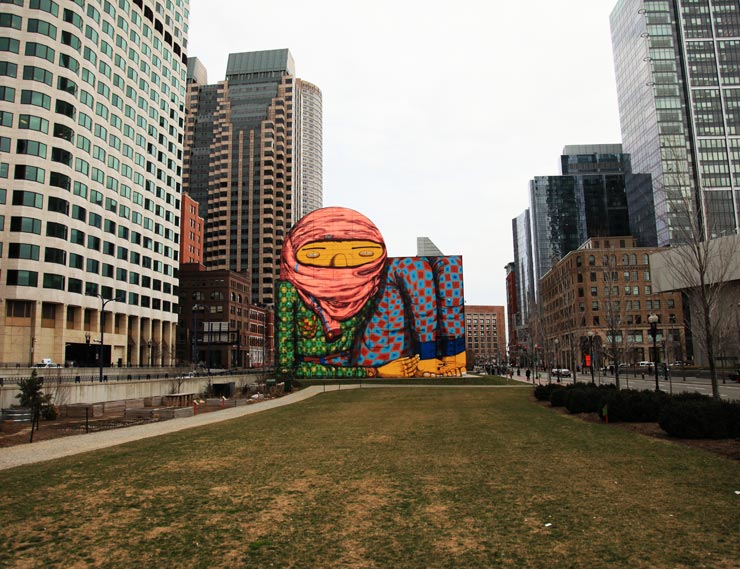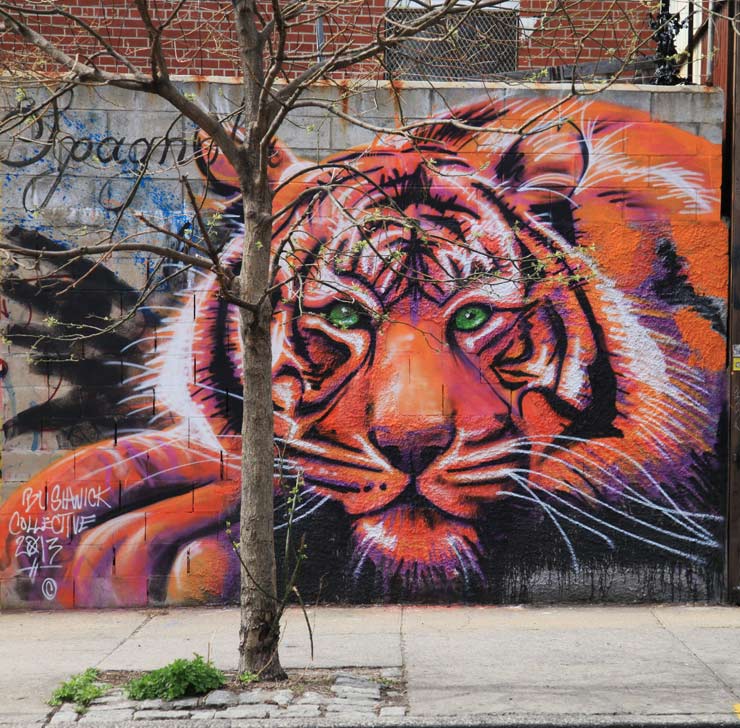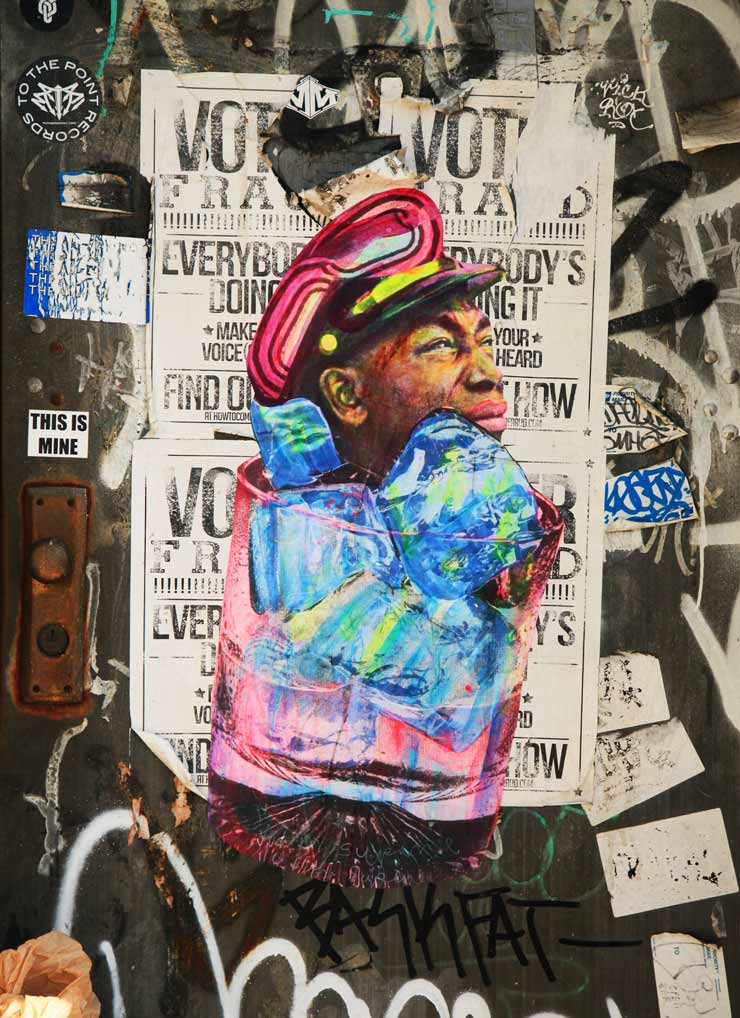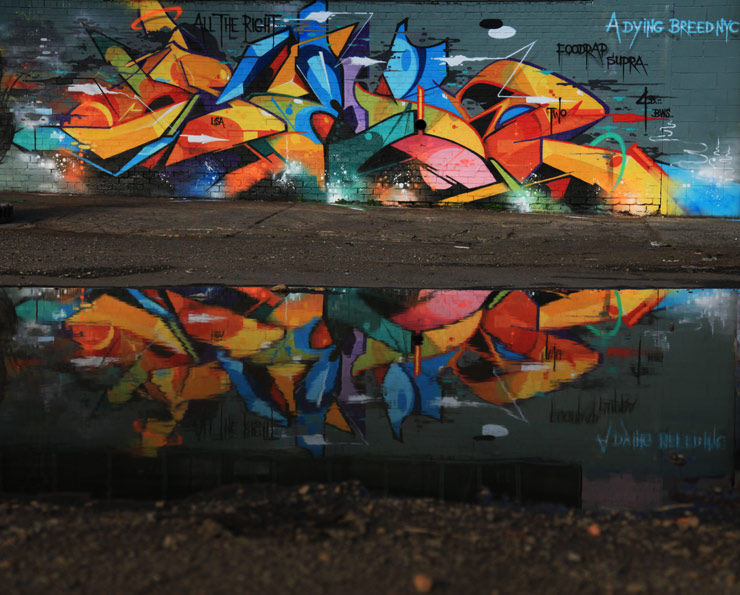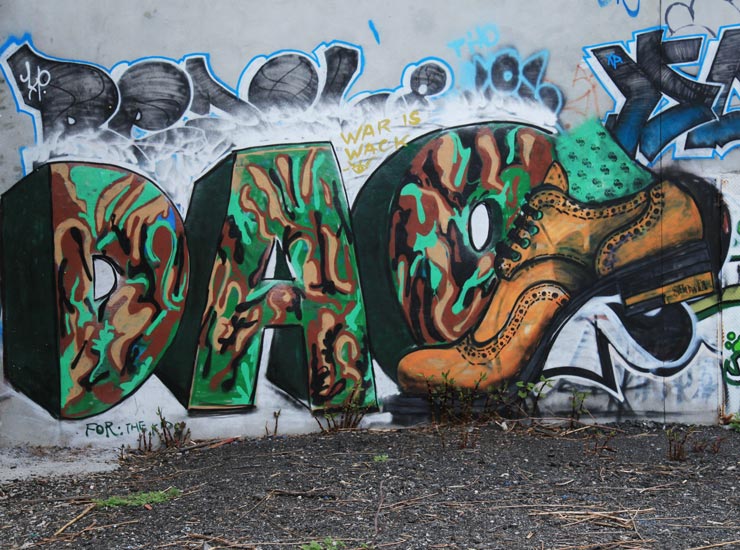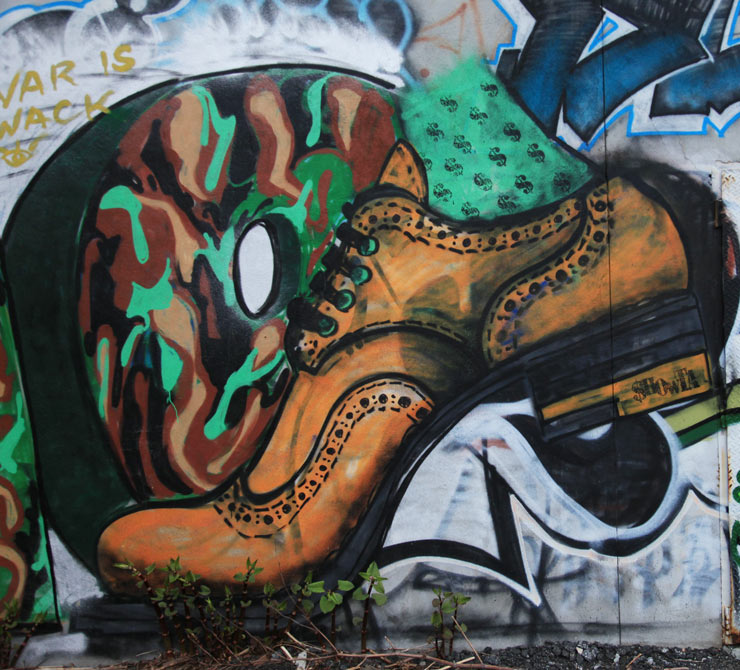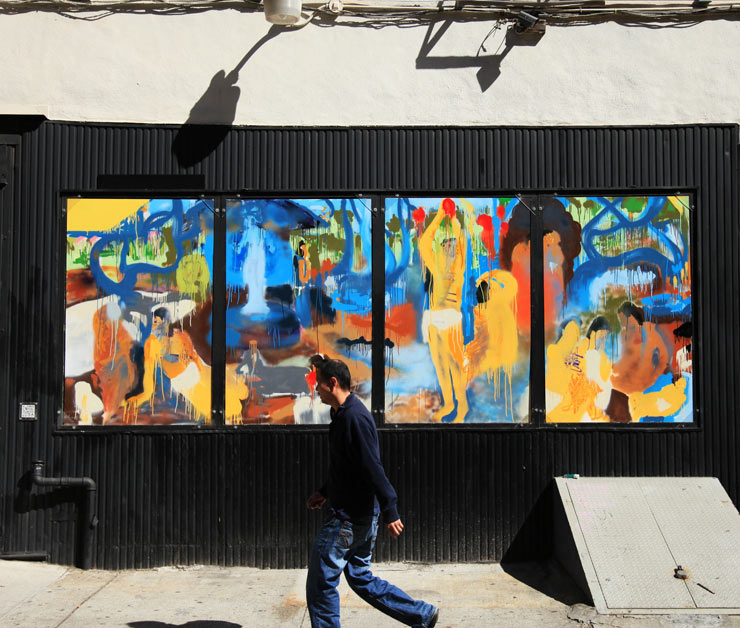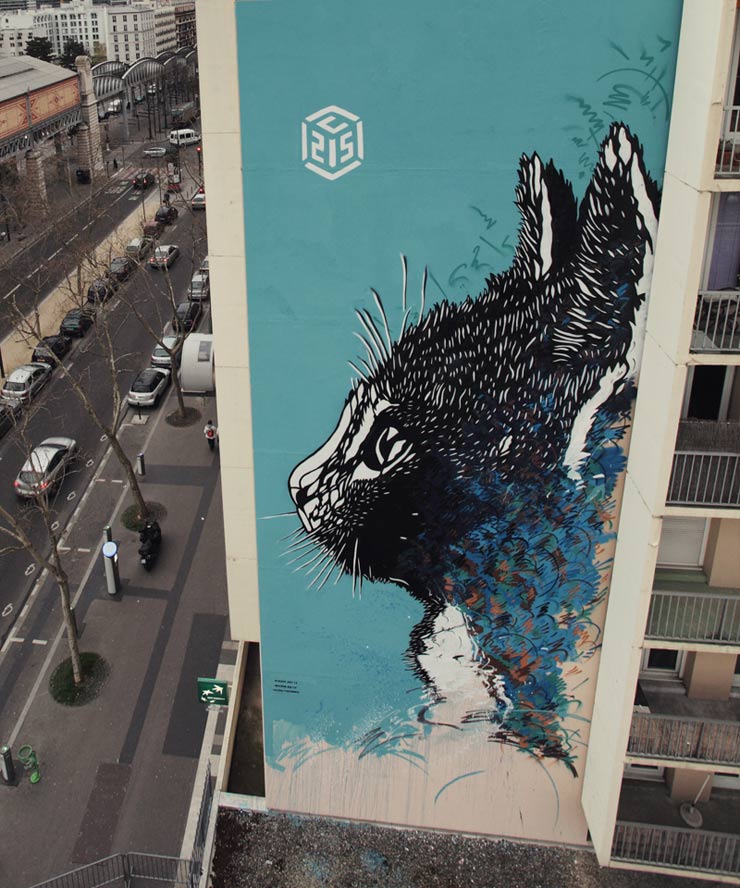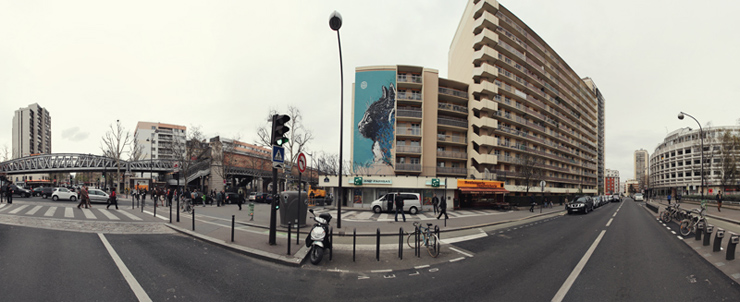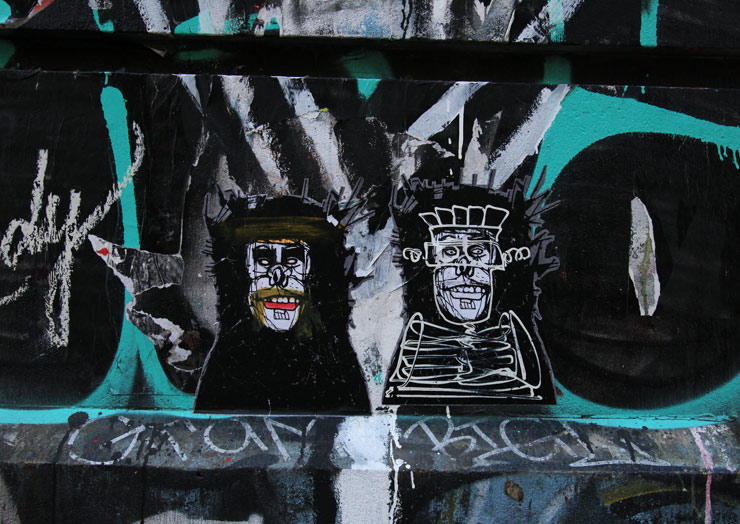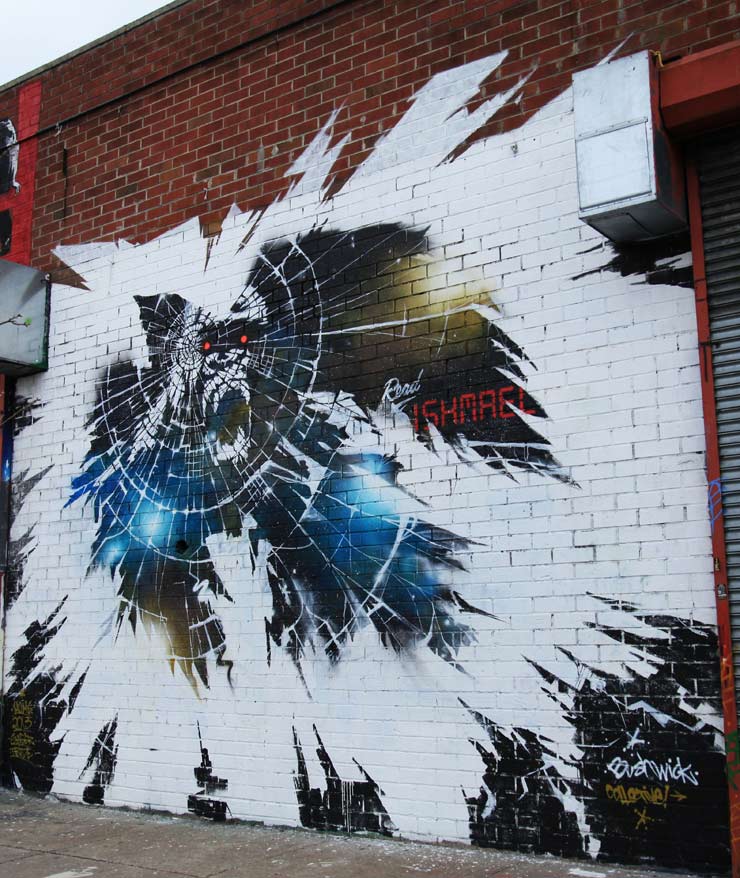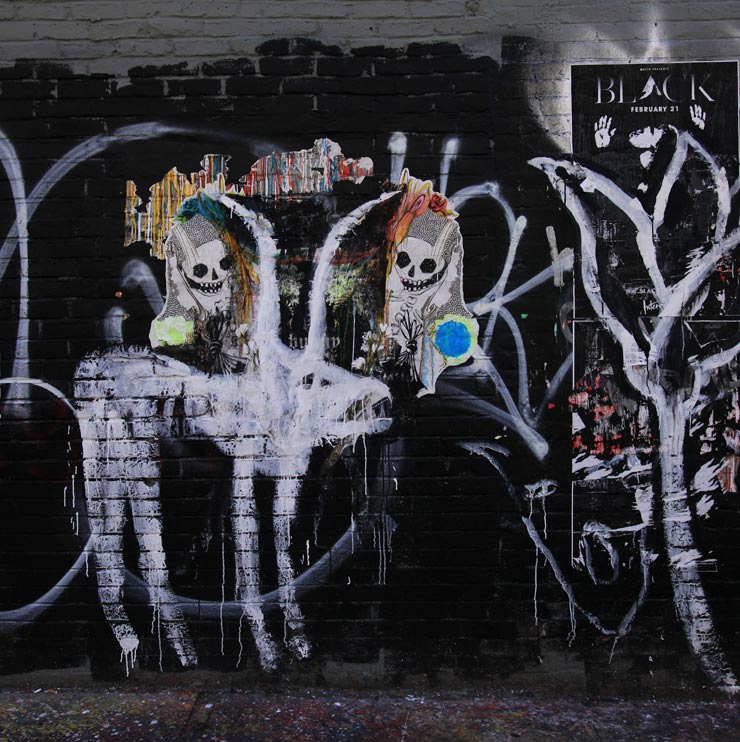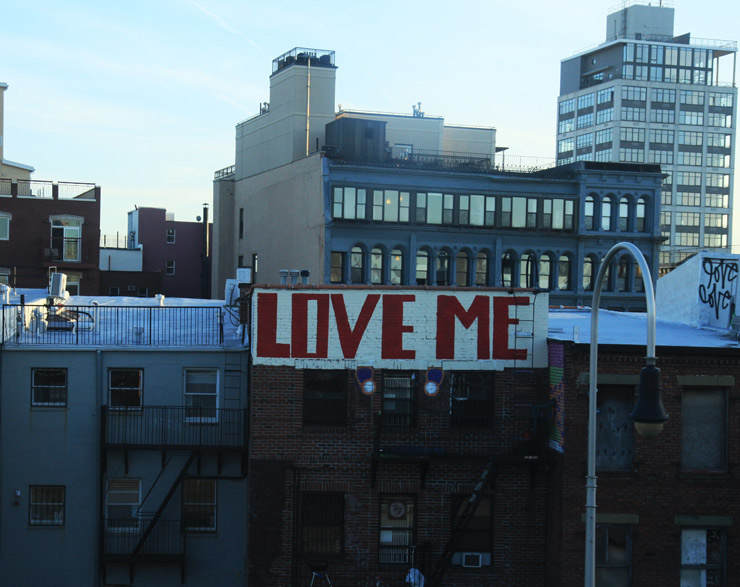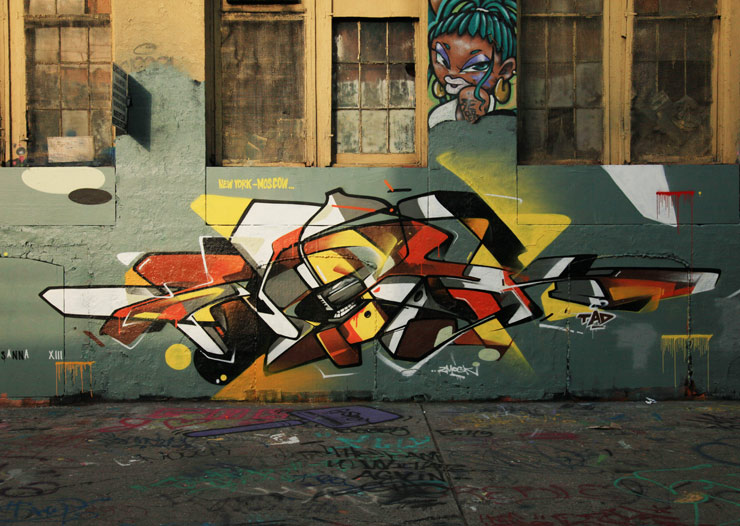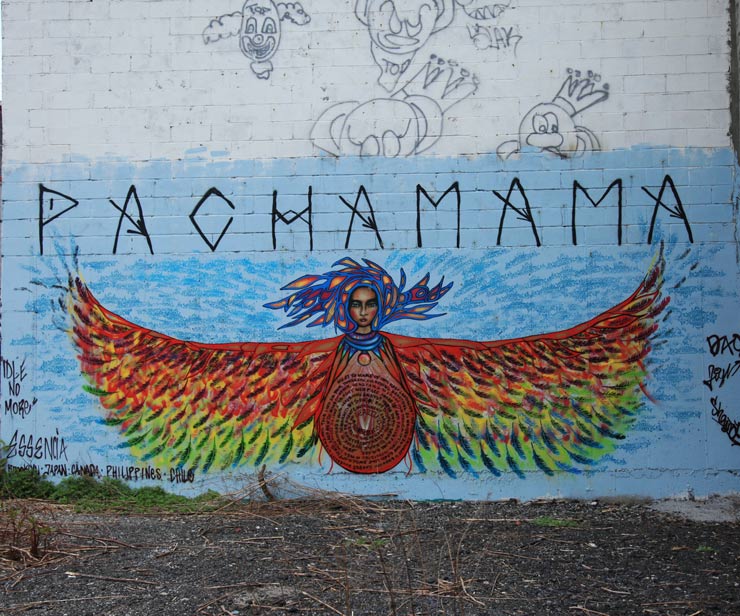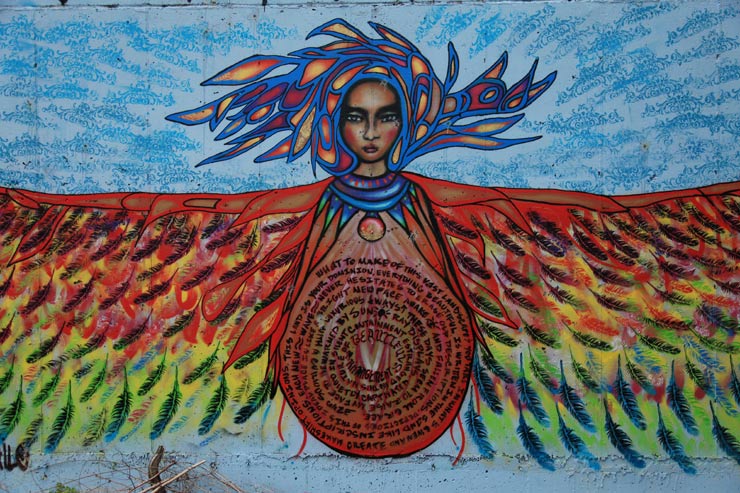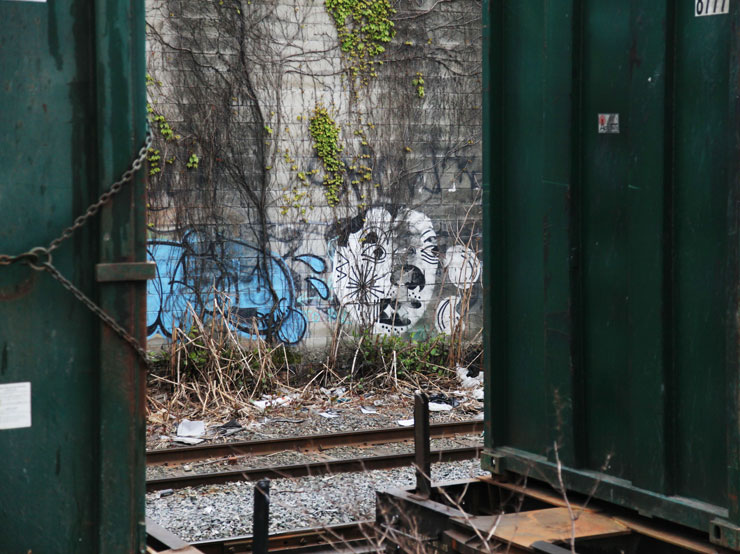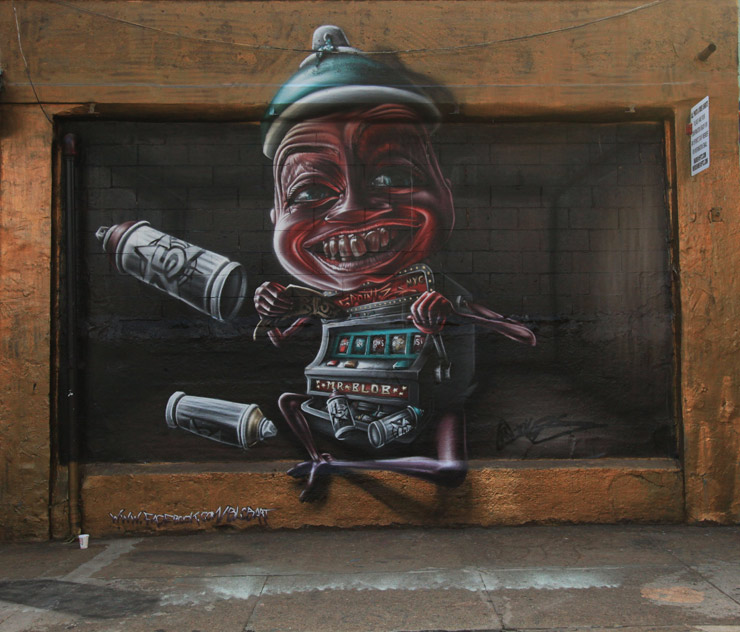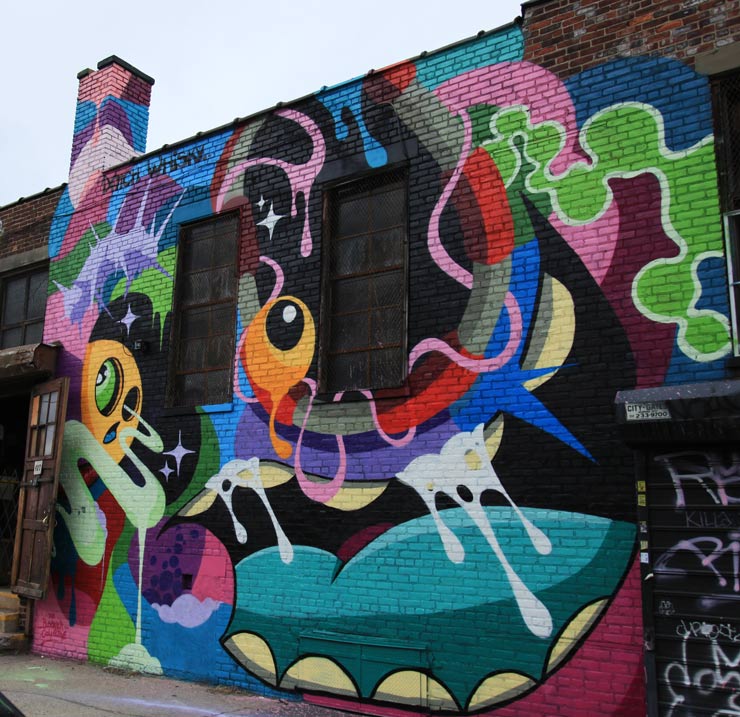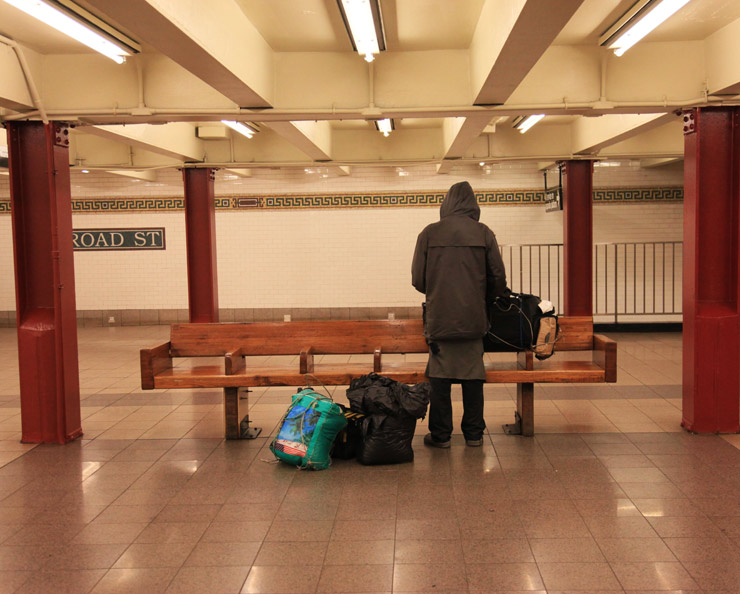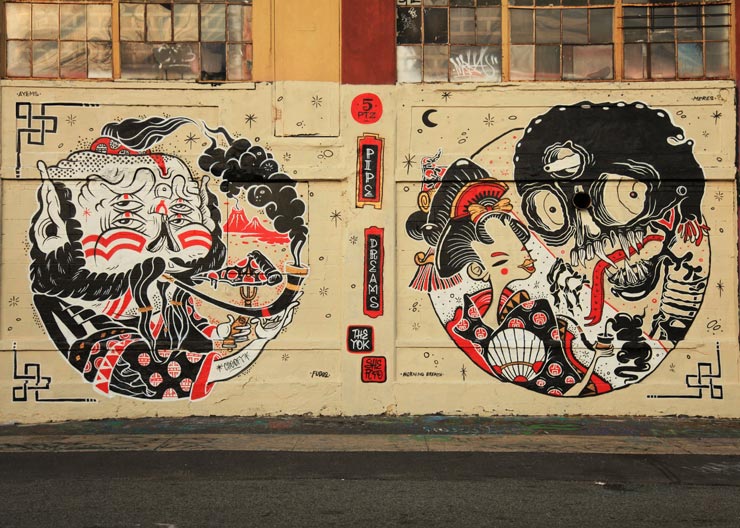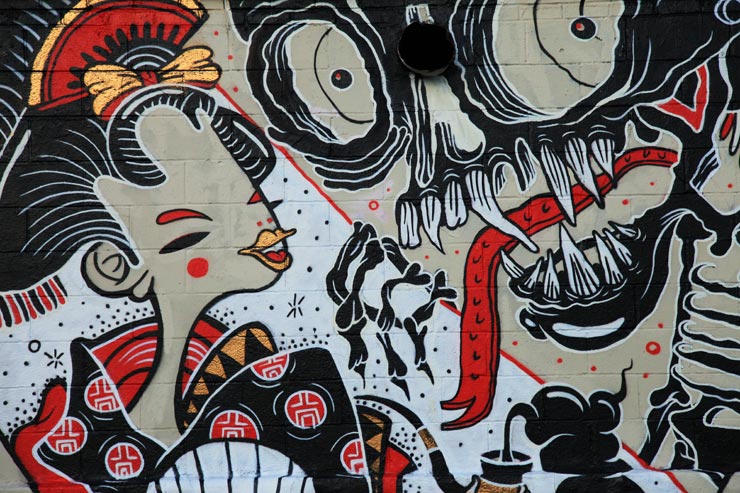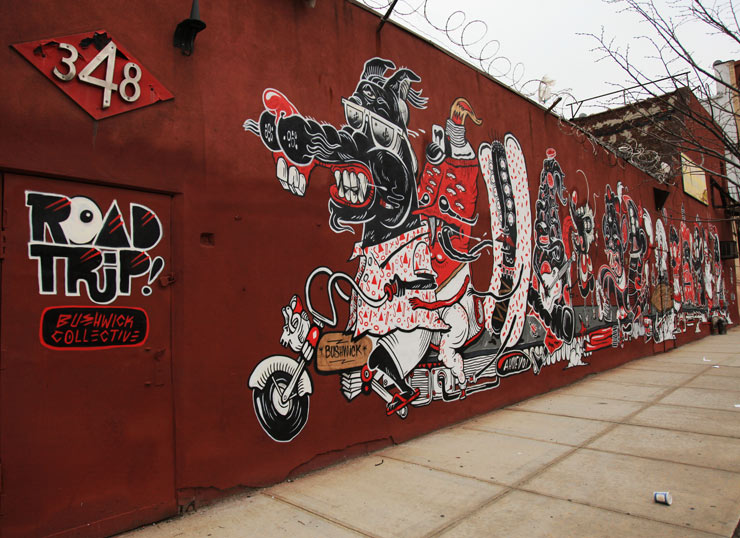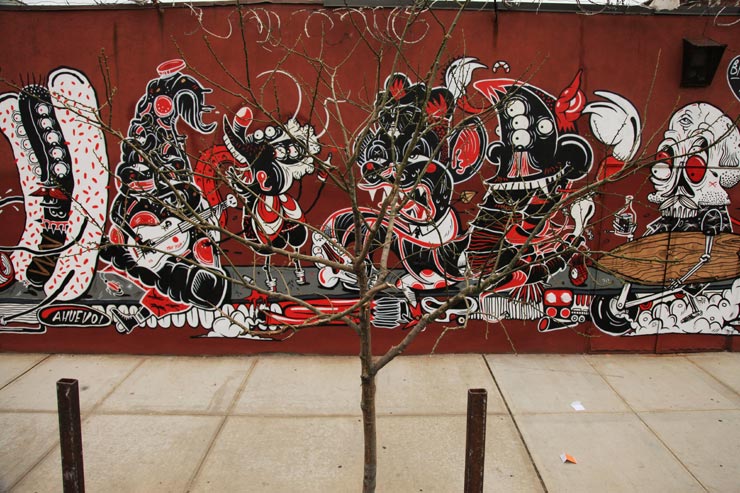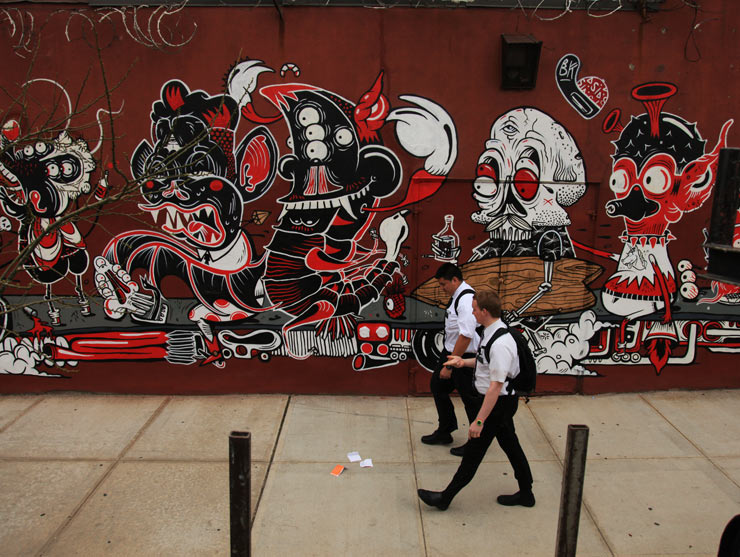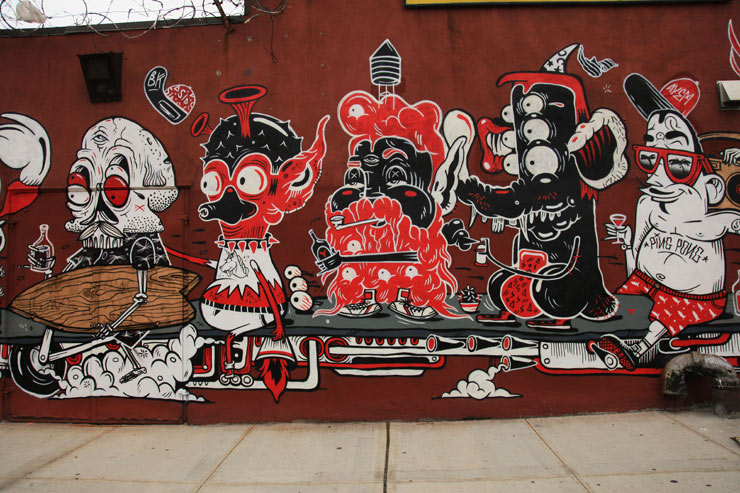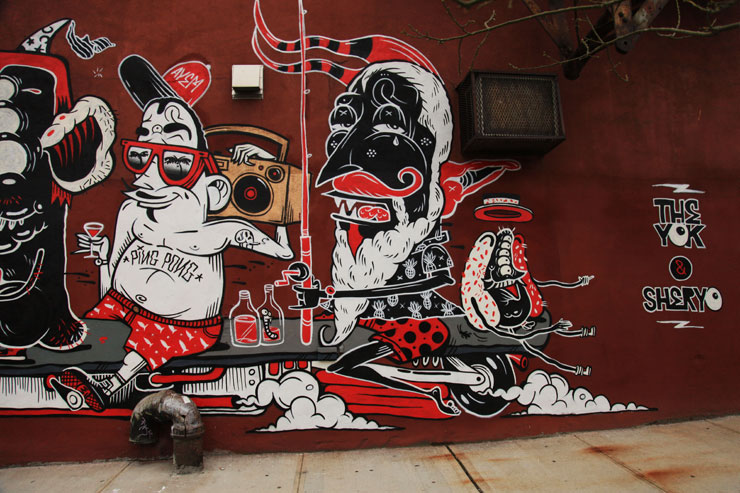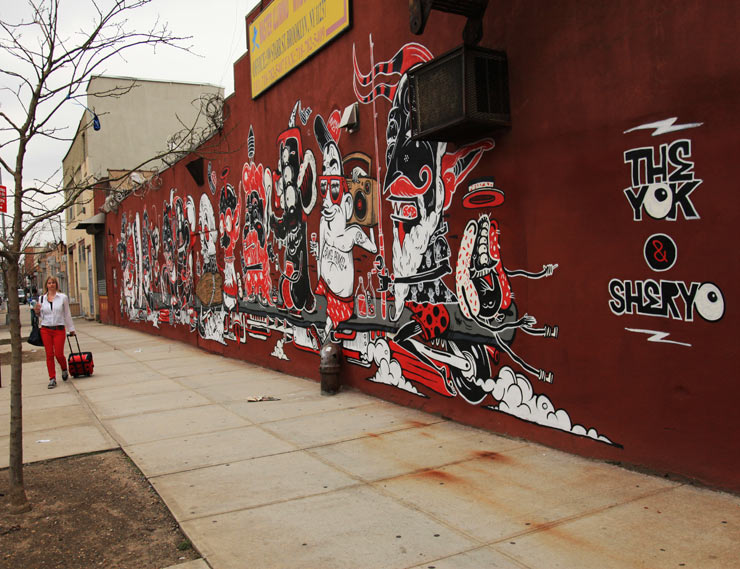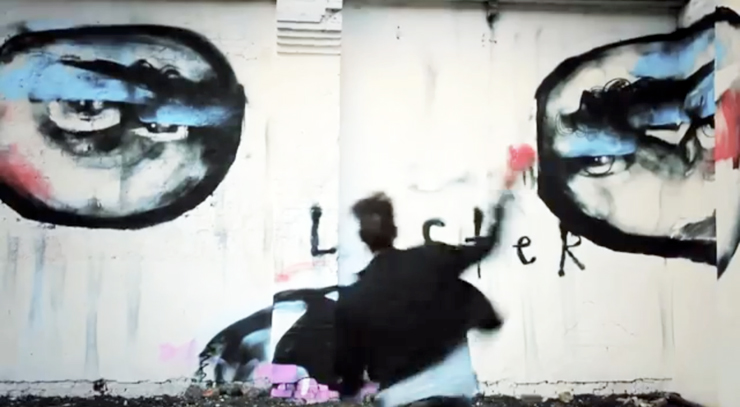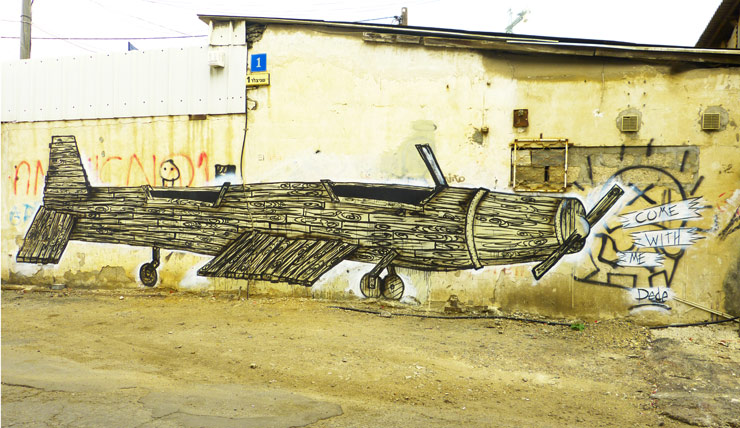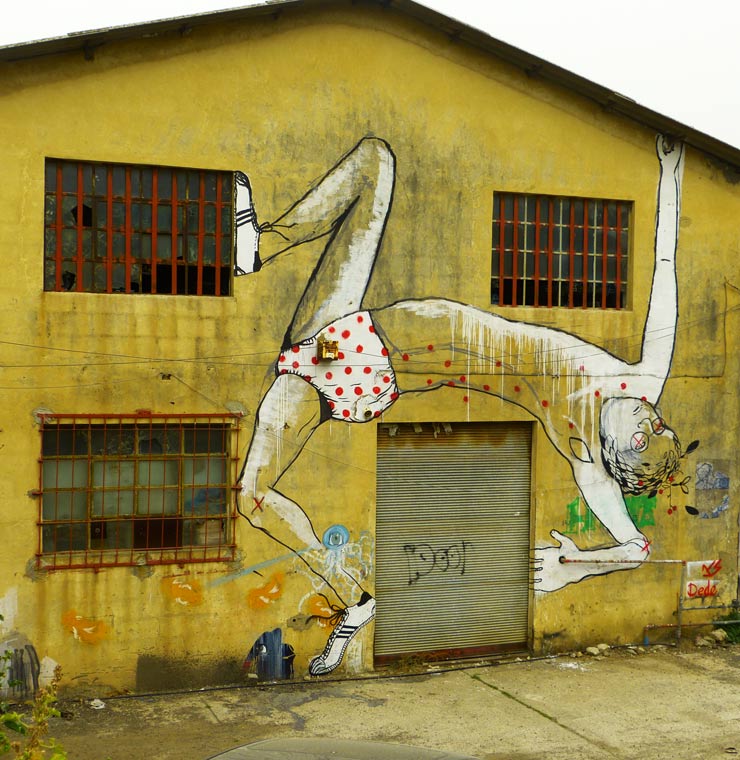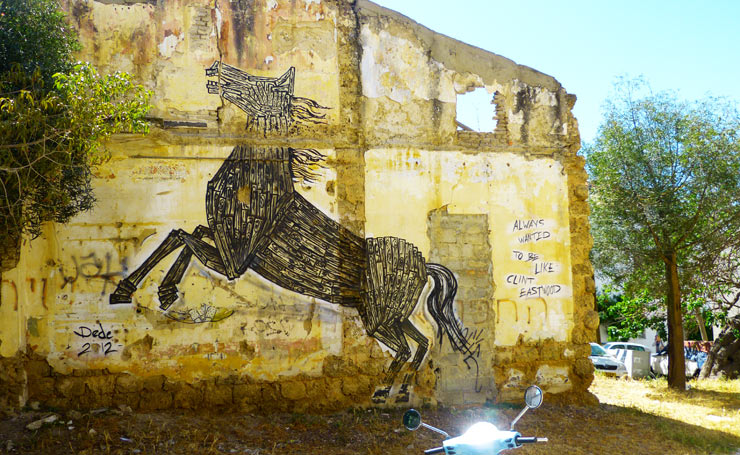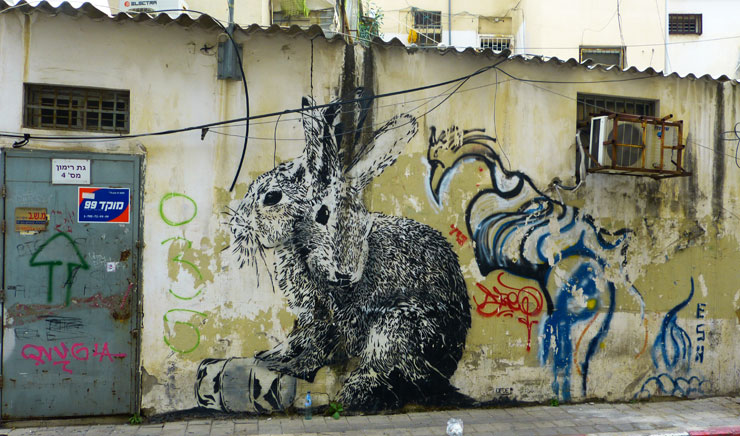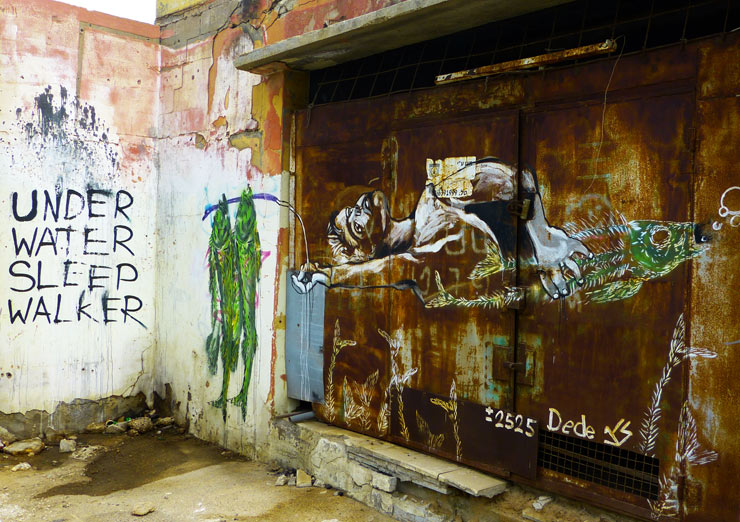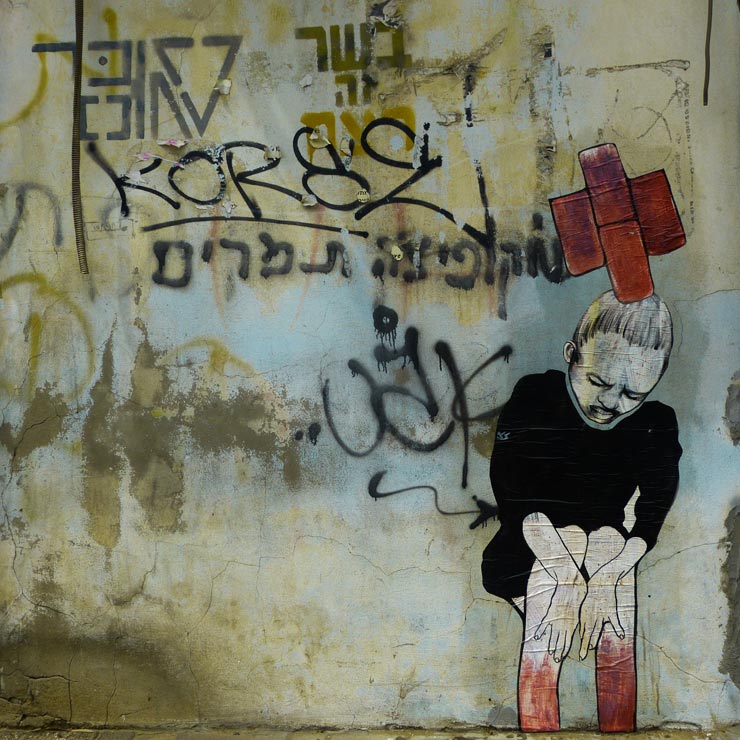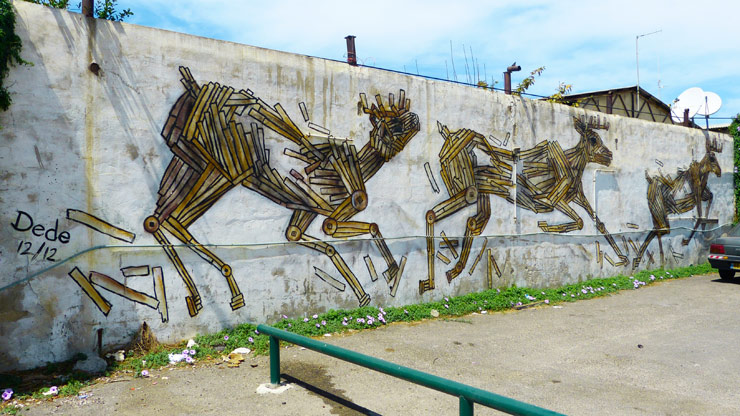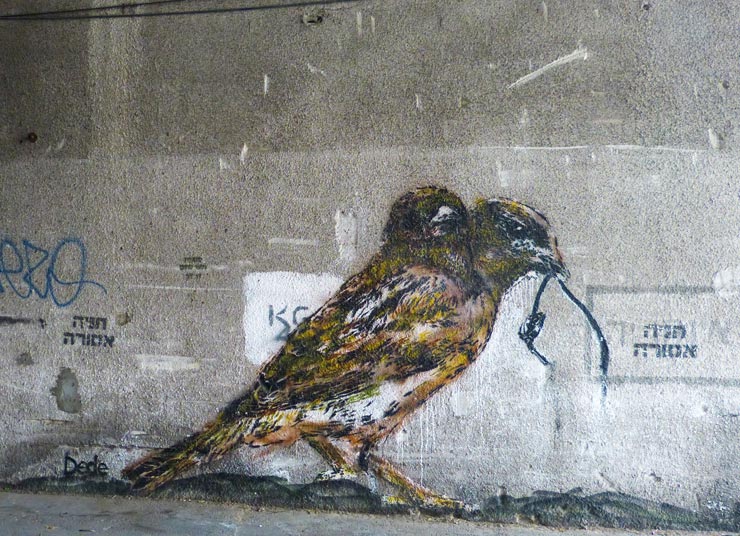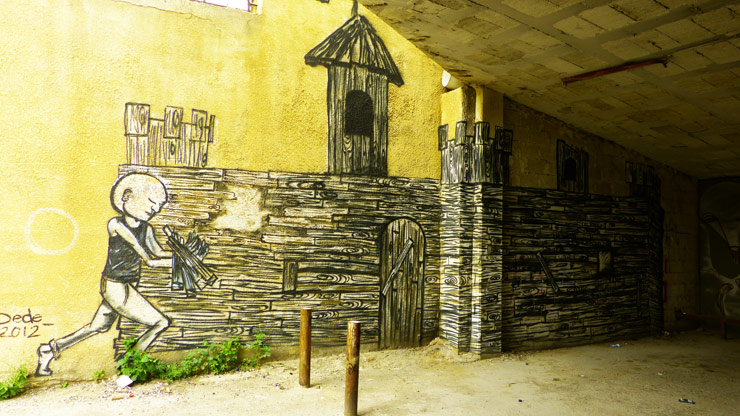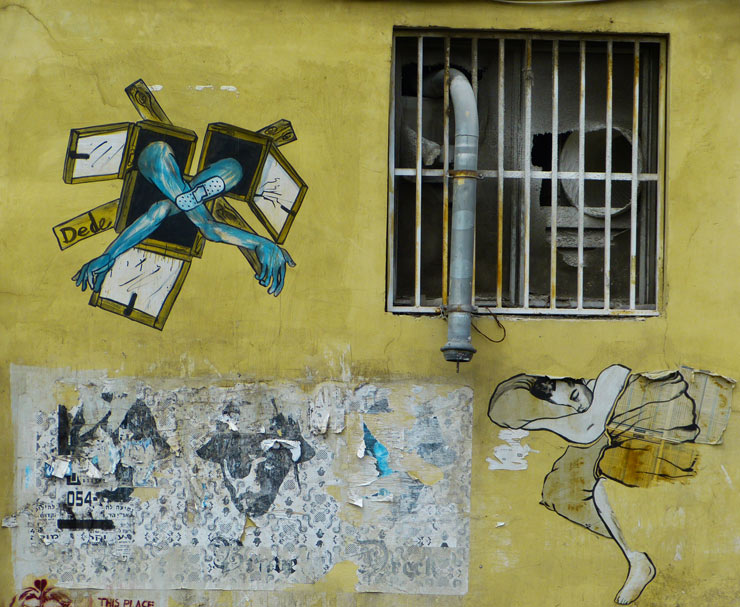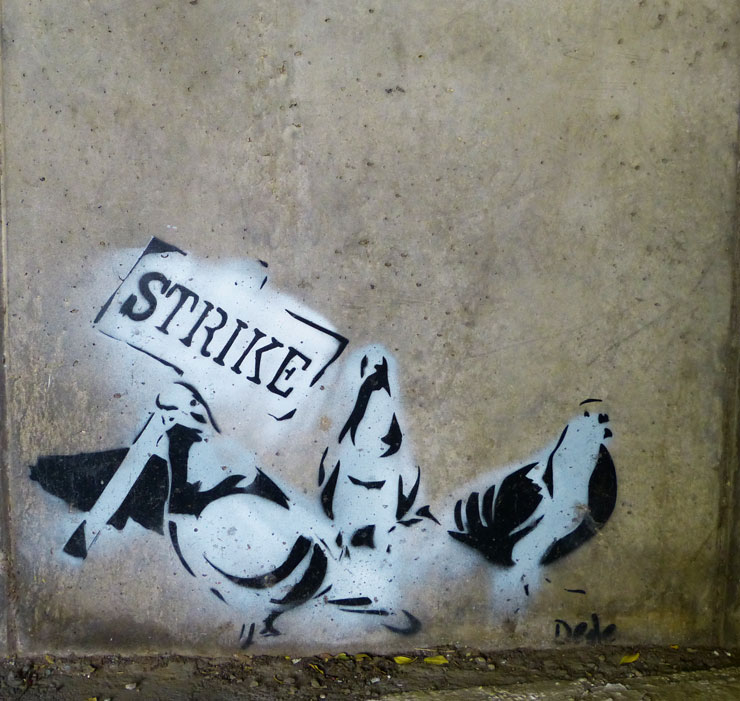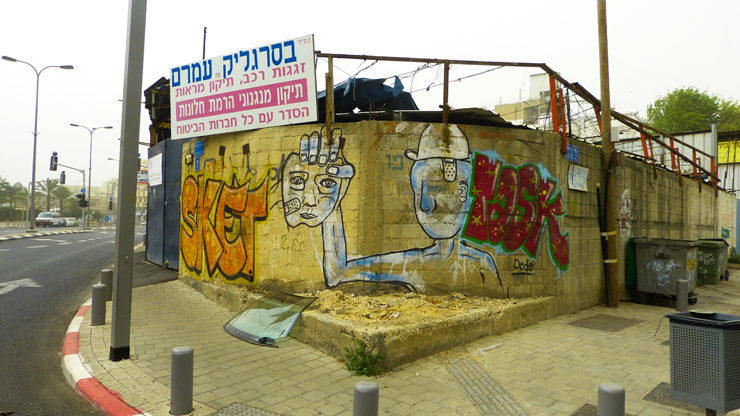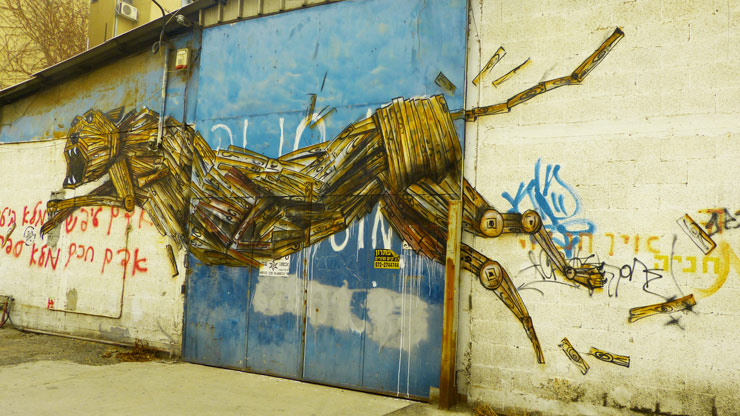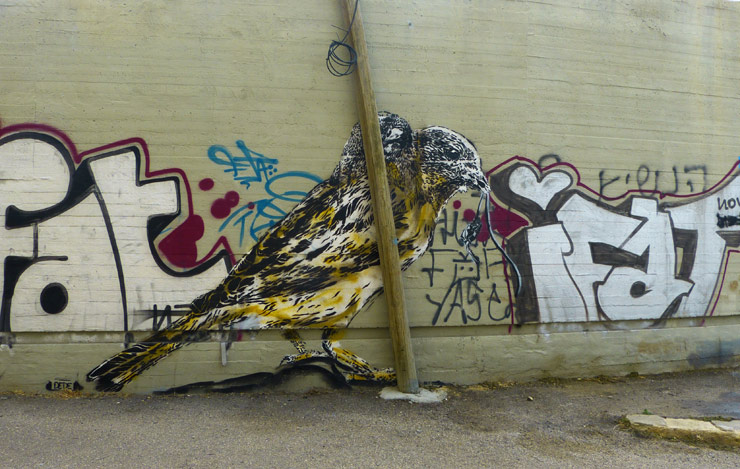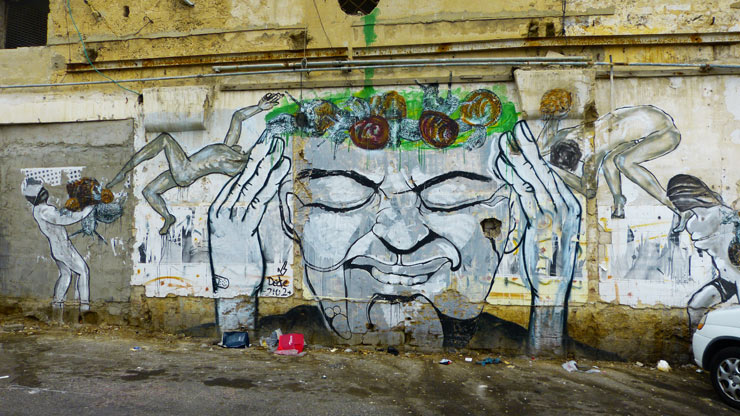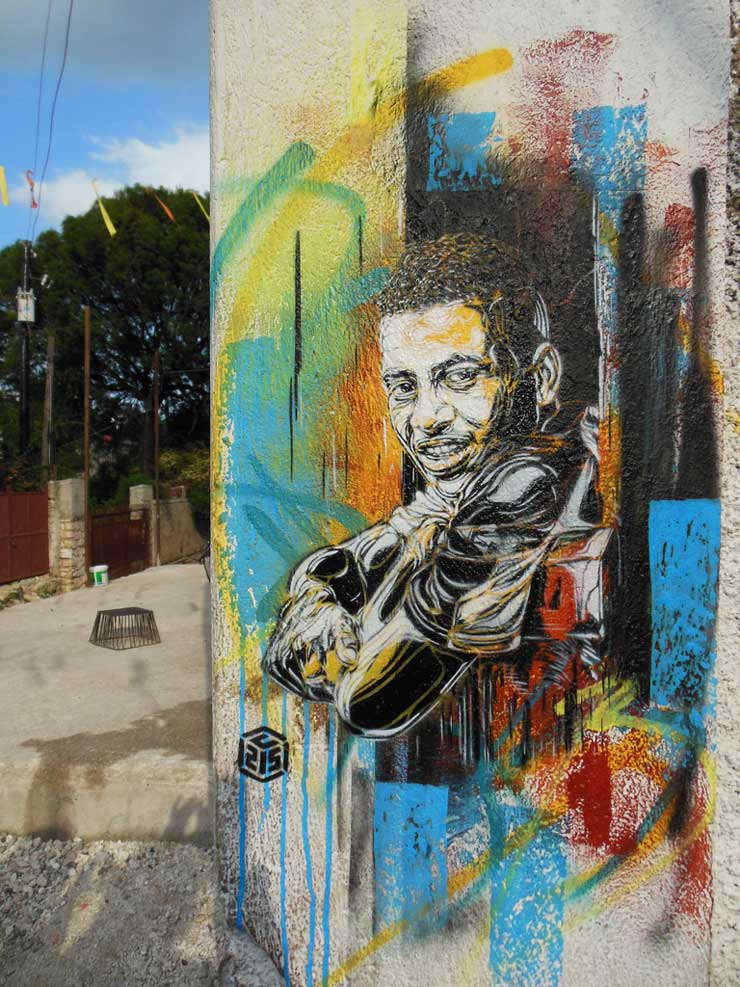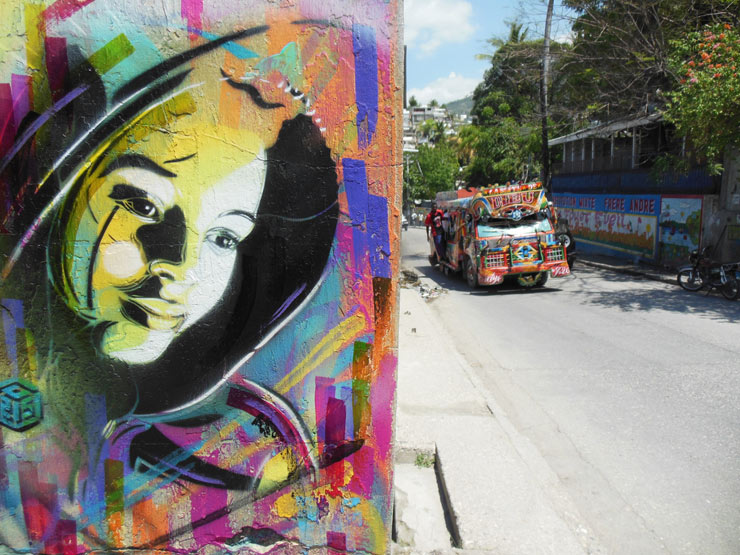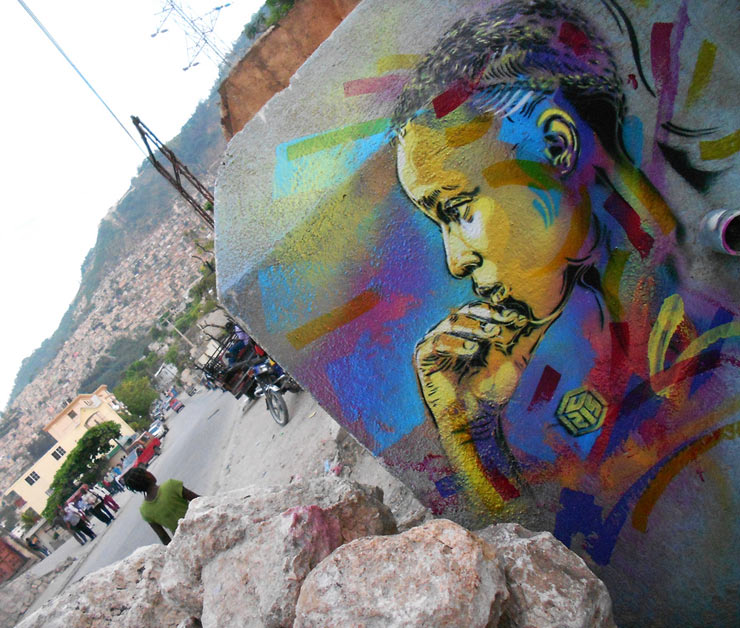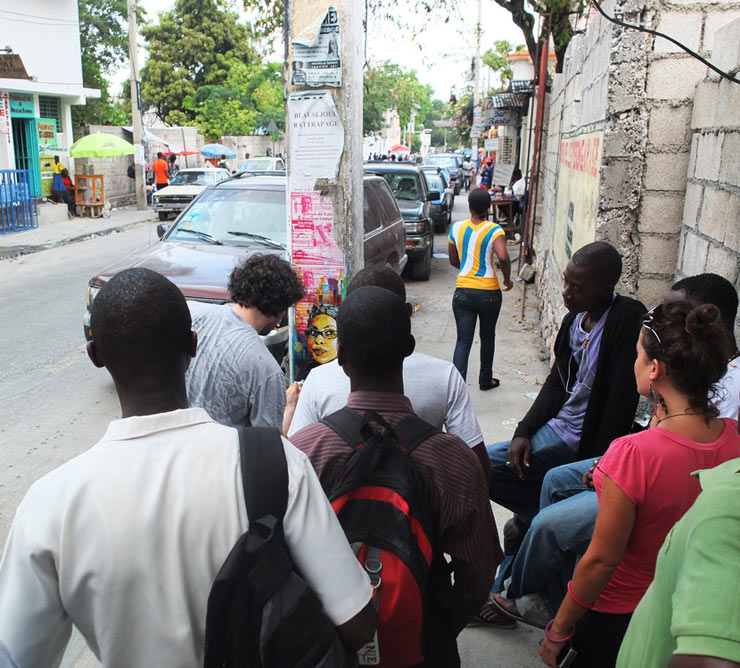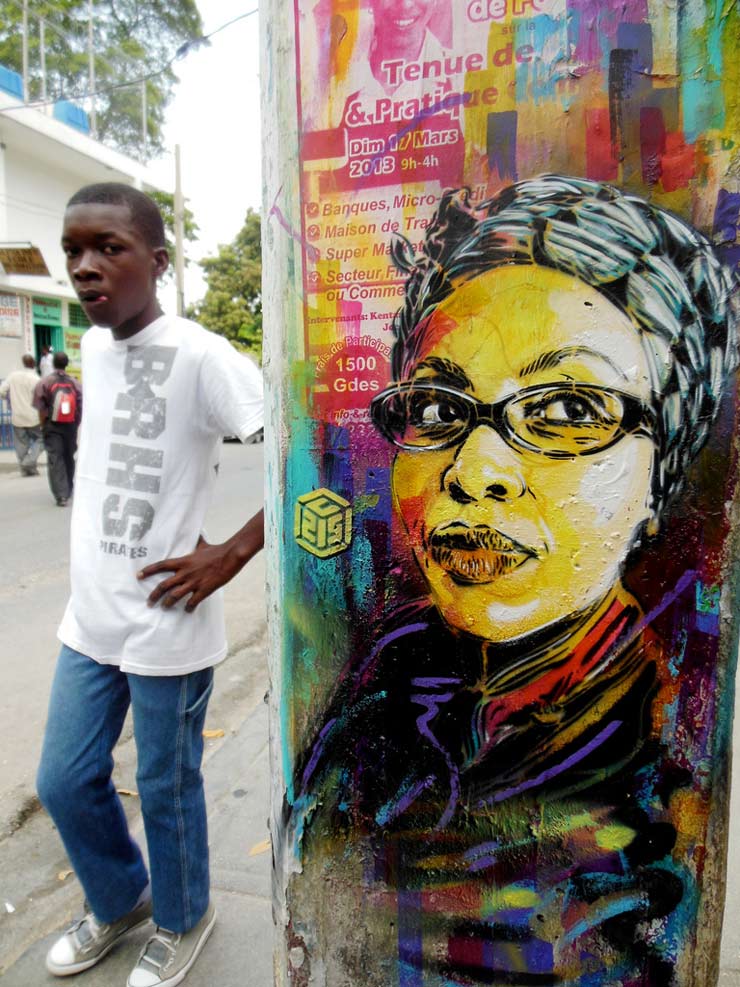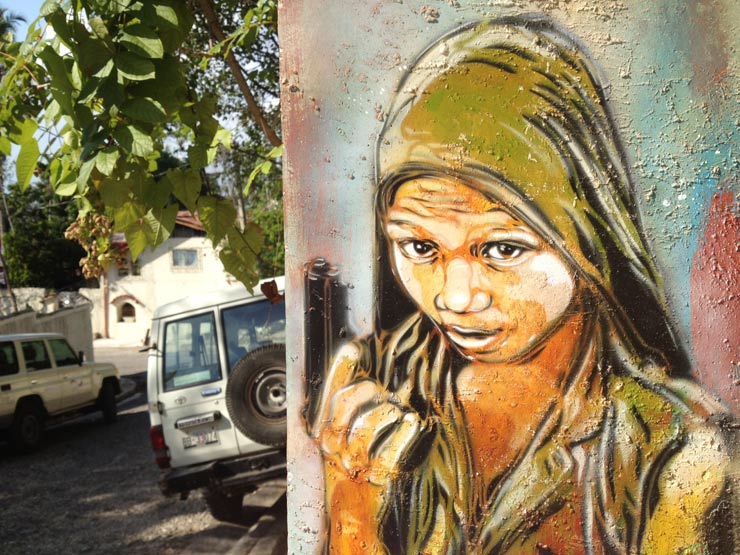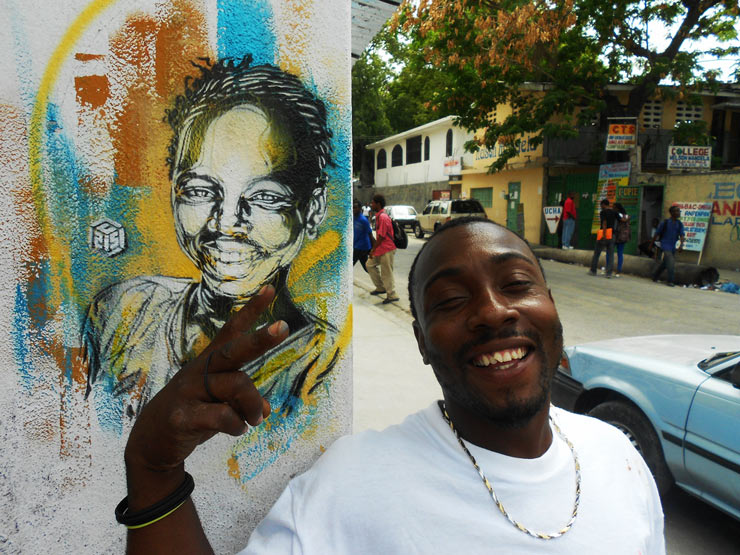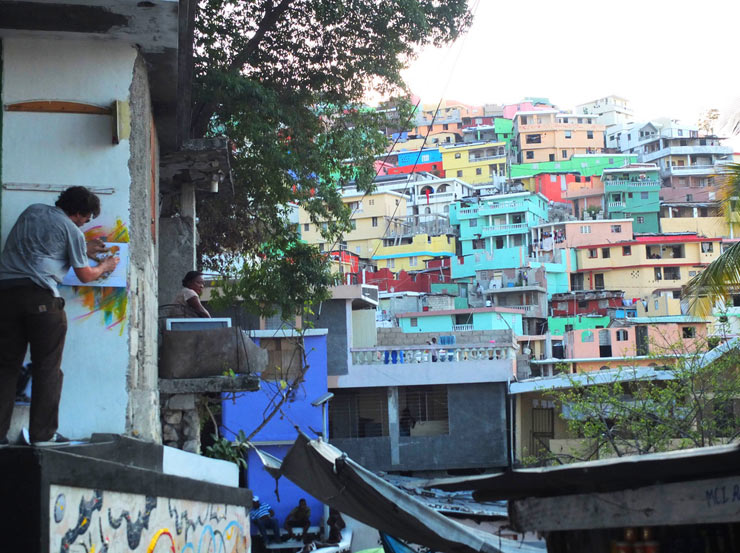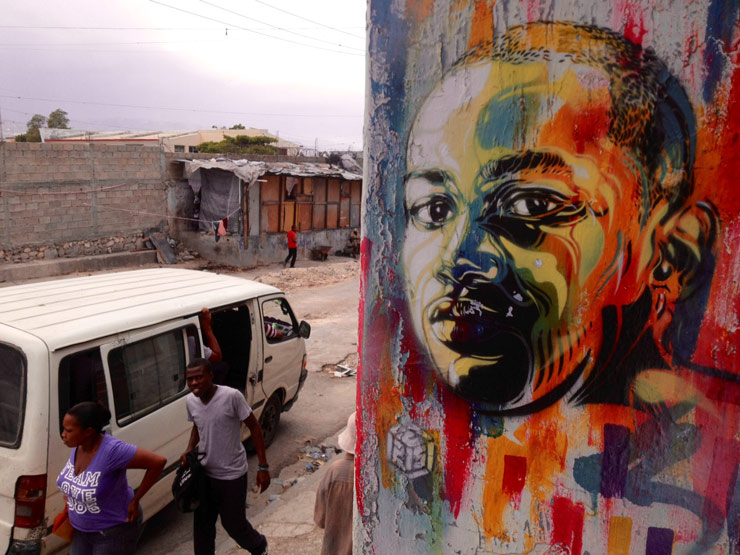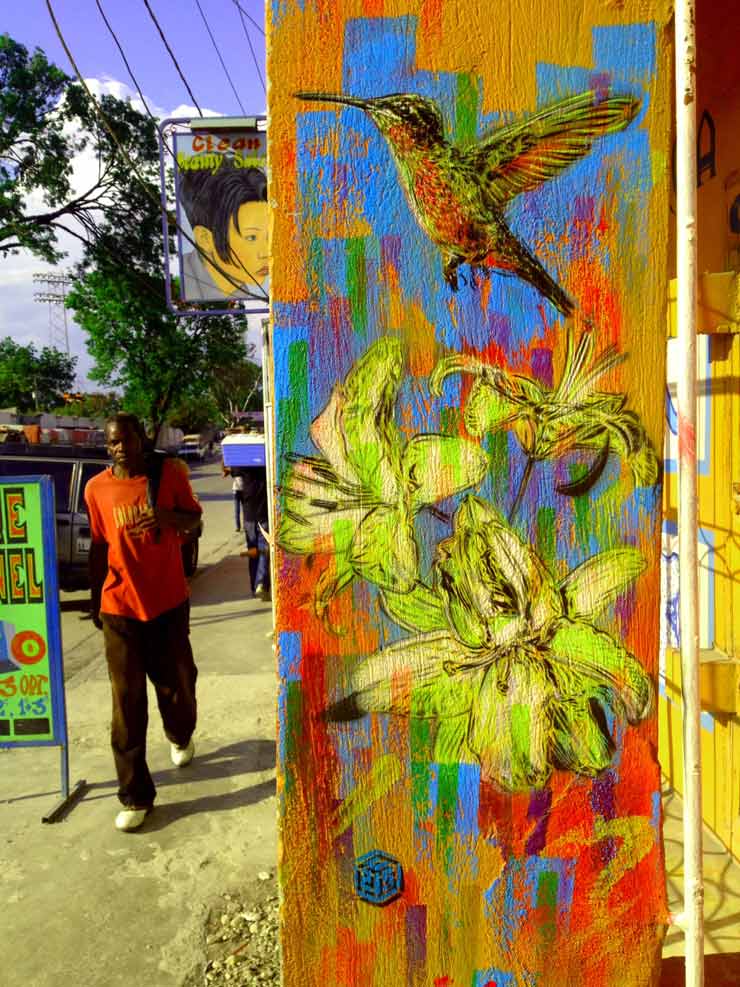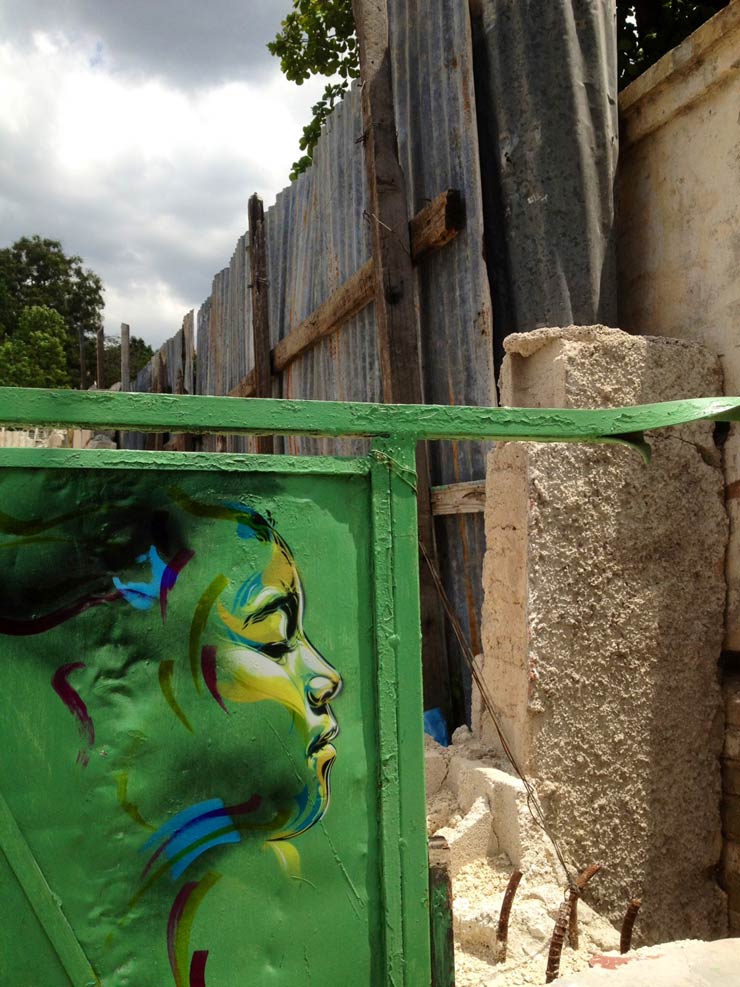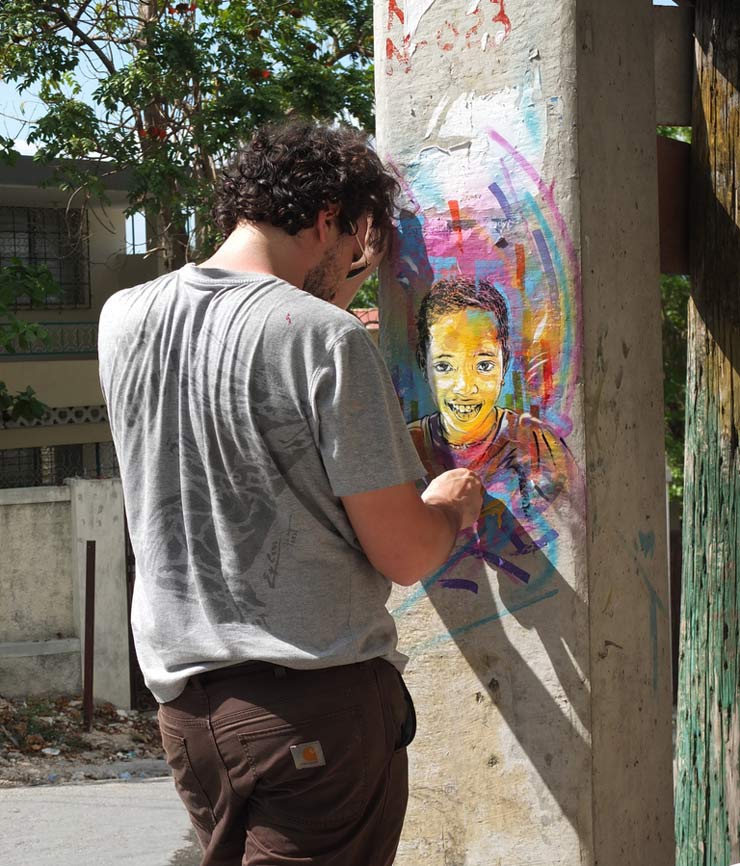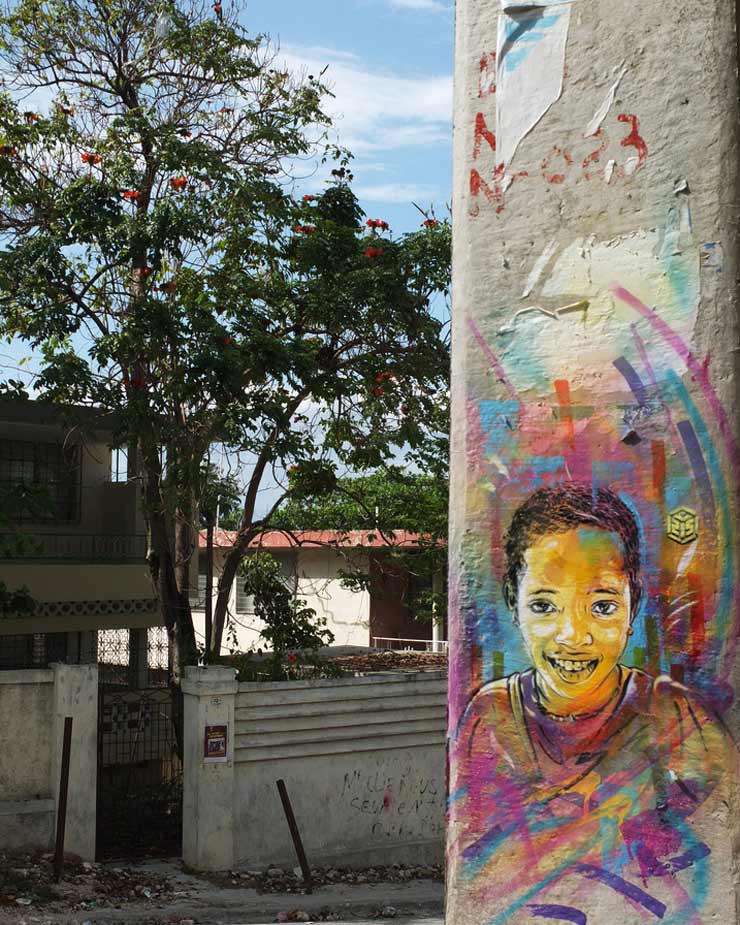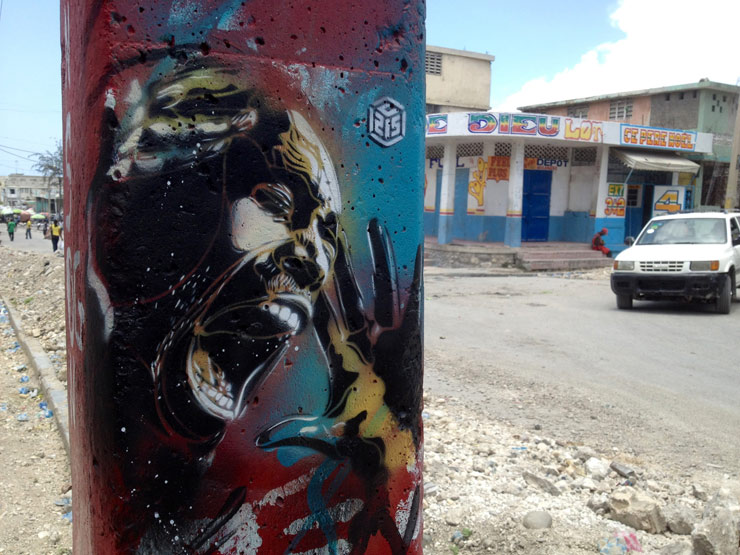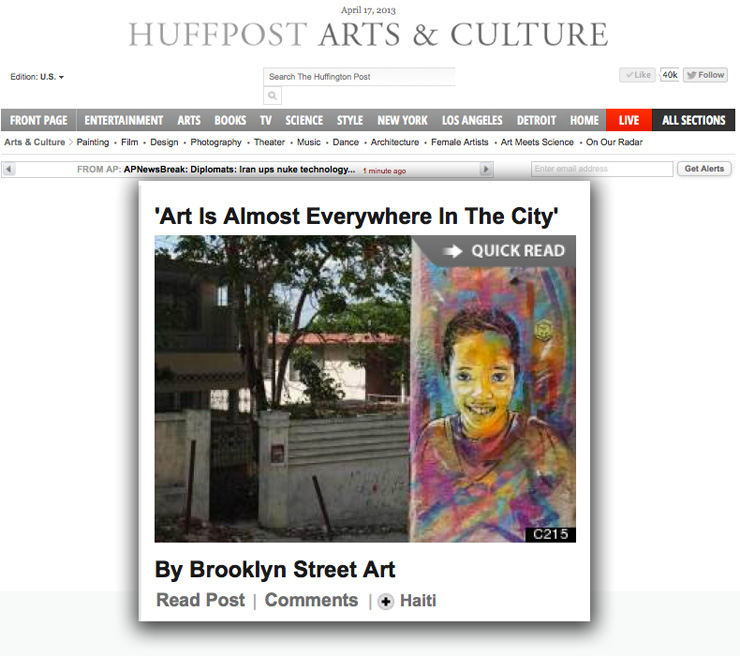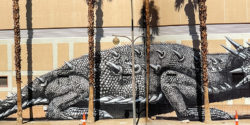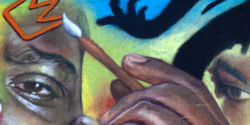| MY IDEA OF FUN |
|
I’ve been working round the clock to finish all the new pieces for my solo exhibition. Its taking place at Stolen Space gallery and opens this Friday, 26th of April, from 6 to 9pm. Please come down and say hello. The show will be running until Sunday 5th of May. See below for links to what else i have been doing, hope this finds you well and see you at My Idea Of Fun. David.
http://cargocollective.com/davidshillinglaw/My-Idea-Of-Fun
|
April 2013
Galerie Itinerrance Presents: BOM.K “Vertiges et somnolence” (Paris, France)
A Grimey Organic Group Wall Grows in Bushwick
The audacity of the organically grown Street Art and graffiti wall, covered with styles and sentiments that are anybody’s guess, people painting whatever the heck they want. It may not be easy to digest, but maybe you’ll find part of it to be inspiring, or challenging, or eye opening. Or all three.
“One person did drive by and yell out the window, ‘This is awful!’ ” says artist Don Pablo Pedro as he lets out a belly laugh. “So that was fun, that was a good one. Other than that I’ve enjoyed it a lot.” He’s talking about the new wall still in progress in Bushwick Brooklyn that is taking shape without input from anyone but the artists. “Yeah there are no real rules, we’re just going out there and having fun. Not trying to do anything that is too important or anything,” says Pablo as he talks about his blue Jesus character with the chastity belt.
Don Pablo Pedro, Smells, Cash4 and Keely. (photo © Jaime Rojo)
Usually this sort of work appears on abandoned lots where only few eyes will see it, not on this corner in the still industrial, intensely trafficked, sooty smelly occasionally ear-splittingly loud part of Bushwick. Here you are greeted by very aggressive truck drivers caterwauling by on 18 wheels like bats out of hell. If you are not alert you can be mowed down or choked by the gritty air along with growing numbers of desparados who have settled here in recent years as artists, students, and low-wage workers continue to migrate in search of affordable space to live and work.
Many of the artists painting on this wall come from different directions and backgrounds – graffiti, street art, fine art, painting, woodworking, screen-printing, sculpture – and many have worked collaboratively before. Smells is the curator, if for no other reason than there had to be some sense of order, and according to Don Pablo it won’t be finished until its completely covered. So far the collection includes work from Smells, Cash4, Droid, UFO, Gentu, Keely, Sadue, Don Pablo Pedro, Tony Bones…. “I think it’s still going to go on, it’s kind of a ‘progress wall,’ ” says Pedro.
Don Pablo Pedro, Smells. Detail. (photo © Jaime Rojo)
“Now the wall has turned into sort of a more grimey wall, which I love about it. It’s my friends building and he kind of loves that too. It mirrors more of him actually.”
Does he find that passersby have a negative reaction to some of the content of his piece – the nudity, genitalia, the multiple additional boobs? “You know, I was hoping so! I have seen a number of people look at it and laugh, like some of the worker guys in the neighborhood.”
And for this neighborhood, if you call it that, community standards divine that this explosion of tags and characters is cool, not that some of these artists give a rats butt. “The neighbors are really nice. They know most of the artists – the people next door have the art materials place and they’re really nice too.”
Don Pablo Pedro, Cash4 and Keely. Detail. (photo © Jaime Rojo)
For Don Pablo Pedro, it’s the genuine artistic freedom he is attracted to and as part of his own practice he finds that he’s still learning about doing collaborative work with others and how to work with rough walls – since his typical practice is on canvas and is done solo and in a studio.
“This is also kind of new for me because I’m working with other people’s art pieces around mine and also the little nuances in the wall; like when I was doing the Jesus figure there were these little weird nail things that were on either side of the door so I used them. Also there were like some little nipple things so I used them. And I think Smells liked using the thing for the vagina so it could sort of spray out. Smells piece is really good. I love that one, it’s really good,” he says enthusiastically.
Don Pablo Pedro working on a fourth character. (photo © Jaime Rojo)
907 Crew . Keely. Detail (photo © Jaime Rojo)
907 Crew . Detail. (photo © Jaime Rojo)
The Whole Gang. (photo © Jaime Rojo)
<<>>><><<>BSA<<>>><<<>><><BSA<<>>><><<>BSA<<>>><<<>><><BSA
Please note: All content including images and text are © BrooklynStreetArt.com, unless otherwise noted. We like sharing BSA content for non-commercial purposes as long as you credit the photographer(s) and BSA, include a link to the original article URL and do not remove the photographer’s name from the .jpg file. Otherwise, please refrain from re-posting. Thanks!
<<>>><><<>BSA<<>>><<<>><><BSA<<>>><><<>BSA<<>>><<<>><><BSA
The Rise of Permissioned “Street Art” Walls
Who Decides What the Content Is on These “Street Art” Walls?
There has been a lot of discussion among Street Artists recently about the rise in the number of permissioned/commissioned walls that people are getting up on. Not strictly regarded as Street Art by some once it crosses over onto legal walls, an increasing number of graffiti and Street Artists are choosing to create on slabs of edifice by permission from private landlords and as part of festivals, fairs, or business improvement districts all over the world.
You could see this coming of course – the evolution of perceptions about Street Art and graffiti can be traced to many changes in society, but we won’t enumerate them here today. Suffice to say there is growing evidence that the public fascination and embrace of the scene is fueling a growth of legal walls in cities across the globe.
People who like this development say that it is good that Street Artists are getting an opportunity to develop their work with the luxury of time and without looking over their shoulder, even if it takes away from the “rebel” cache that may be attached to a traditional under cover hit-and-run technique. But a few more critical voices on and off the scene are positing that some of the actual work produced is getting sort of dull and decorative.
We know from experience from providing many artists the opportunity to get up on a legal wall that sometimes a landlord will grant permission on the condition that certain restrictions apply. Often they relate to things like nudity, profanity, local neighbors opinions, even certain points of view. Other times they want the artist to include a shout-out to them, their business, or their nephew’s favorite superhero. In one way or another, the complete unfettered artistic freedom of the artist is almost always tempered by these considerations.
Os Gemeos “The Giant of Boston” at The Rose Kennedy Greenway at Dewey Square Boston. 2012. Click here to read our coverage of this installation on the Huffington Post. (photo © Jaime Rojo)
It reminds us of Boston last year when Brazillian Street Artist Os Gemeos put up a piece by permission in a prominent location in the city in conjunction with a solo show they had at Boston ICA. Not exactly Street Art? Clearly, it would be better described as a mural on a public piece of real estate. But the vetting process for approving the content was criticized, and the character depicted in the final piece set off a brief firestorm of hysteria that most dismissed as racist rantings, but some took their opinions seriously enough to demand it be taken down. It’s still up by the way.
We’ve seen ‘Public Art” applications from city agencies that are so laborious and convoluted and include so many cooks in the kitchen that you are virtually assured that the final product will be a painting of a flower or smiley face. This is probably why many Street Artist will continue to seek walls of abandoned buildings and dingy doorways, even while doing the occasional permissioned wall.
Which leads us to todays bit of blog-spotting that we bring you from Marni Soupcoff on Huffington Post Canada who poses the question “If the Public Owns the Wall, Does It Get a Say in the Pictures?” Managing Editor for Blogs and 4th generation Torontonian, Soupcoff talks to two guys on both sides of that discussion, and asks you to offer yours.
“Who gets to decide exactly what form the art will take? Should the public — the owners of the property — have a say? The government? Those who live and work in the area? Or is that interfering in the artistic process and getting in the way of the artist’s creativity? Do we want government dictating art?” – read more here.
Images of the Week: 04.21.13

Here’s our weekly interview of the street, this week featuring $hota, Armer, bunnyM, C215, Curtis Kulig, DAO, Demian Smith, Essencia, Gyser, Irade, Joseph Meloy, Judith Supine, Love Me, Meres, Monsieur Plume, Patch Whiskey, Raid Crew, Mr. Blob, Robert Janz, SEN2, Shiro, Smogk, Spagnola, Theo David, and Thomas Buildmore .
Top image > Spagnola (photo © Jaime Rojo)
Brand new Judith Supine on the rocks. (photo © Jaime Rojo)
Sen2 at 5Pointz. (photo © Jaime Rojo)
$howta and DAO (photo © Jaime Rojo)
$howta and DAO. Detail. (photo © Jaime Rojo)
Thomas Buildmore and his homage to Gaugin at Woodward Project Space. (photo © Jaime Rojo)
C215 big cat in Paris. (photo © Théo David)
We’ve seen a lot of fat cats, but never one this big. French Street Artist C215 finished it this week on a wall in the 13th arrondissment of Paris. Demian Smith, founder of Underground Paris, says the chat géant is “part of the neighborhood’s strategy to create an alternative tourism industry in this pretty ugly, working class area in the south of Paris.” – Not the first time that Street Artists have perked a place up, just usually not on this scale. The strategy has so far included murals by Shepard Fairey, Inti, and Vhils, he says. Special thanks to Théo David for sharing these exclusive shots for BSA readers.
C215 big cat in Paris. (photo © Théo David)
Joseph Meloy (photo © Jaime Rojo)
Ishmael (photo © Jaime Rojo)
This forced collab with bunnyM and Robert Janz has a wild untamed energy, like a group of teens on a train at 3 pm. (photo © Jaime Rojo)
Sort gets right to the point, right? Love Me (photo © Jaime Rojo)
ZMOGK with Shiro overseeing at 5Pointz. (photo © Jaime Rojo)
Essencia (photo © Jaime Rojo)
Esscencia. Detail. (photo © Jaime Rojo)
Armer (photo © Jaime Rojo)
“Ain’t nothin I’m just tryin to get my paper, my paper.” That’s right Mr. Blob is getting paid at 5Pointz. (photo © Jaime Rojo)
Usually catching walls down south, Patch Whisky stopped in at the Bushwick Collective and also hit the En Masse installation. (photo © Jaime Rojo)
French artist Monsieur Plume of Raid Crew give Meres on the left a shout out at 5Pointz. (photo © Jaime Rojo)
Untitled. J Train. Broad Street Sta. April 2013. (photo © Jaime Rojo)
Thank you to Théo David for shooting the C215 wall in Paris for BSA. Visit Théo’s site here for more of his work.
<<>>><><<>BSA<<>>><<<>><><BSA<<>>><><<>BSA<<>>><<<>><><BSA
Please note: All content including images and text are © BrooklynStreetArt.com, unless otherwise noted. We like sharing BSA content for non-commercial purposes as long as you credit the photographer(s) and BSA, include a link to the original article URL and do not remove the photographer’s name from the .jpg file. Otherwise, please refrain from re-posting. Thanks!
<<>>><><<>BSA<<>>><<<>><><BSA<<>>><><<>BSA<<>>><<<>><><BSA
Sheryo and The Yok, Pipe Dreams and Road Trips
So what did you do on your spring vacation? I know, me neither. But Sheryo and The Yok did and are back in BK after their extended trip that took them to Mexico and Australia where they hit a number of walls on their adventures. Fresh off the plane, they are cracking open the aerosol cans and telling tales about their trips abroad. It seems like in a matter of days they have executed two complete and detailed murals that reveal that their individual styles are sometimes distinct, other times ever-more complimentary on walls in Queens and Brooklyn.
First, in what could possibly be the 5Pointz own version of the upcoming Cherry Blossom season, take a look at “Pipe Dreams”, inspired by traditional Japanese art and calligraphy, with some obvious liberties taken. Afterwards we have a “Road Trip” at the Bushwick Collective, which could be an animated version of the sort of characters they met while tooling around and painting while travelling, and if that’s the case, no wonder they came back!
“Pipe Dreams” at 5Pointz in Queens
The Yok and Sheryo “Pipe Dreams” 5Pointz, Queens. (photo © Jaime Rojo)
The Yok and Sheryo, or is that Sheryo and The Yok, in “Pipe Dreams”. Detail. 5Pointz, Queens. (photo © Jaime Rojo)
“Road Trip” at Bushwick Collective in Brooklyn
The Yok and Sheryo “Road Trip” Bushwick Collective. (photo © Jaime Rojo)
The Yok and Sheryo “Road Trip”. Detail. Bushwick Collective. (photo © Jaime Rojo)
The Yok and Sheryo “Road Trip”. Detail. Bushwick Collective. (photo © Jaime Rojo)
The Yok and Sheryo “Road Trip”. Detail. Bushwick Collective. (photo © Jaime Rojo)
The Yok and Sheryo “Road Trip”. Detail. Bushwick Collective. (photo © Jaime Rojo)
The Yok and Sheryo “Road Trip”. Bushwick Collective. (photo © Jaime Rojo)
<<>>><><<>BSA<<>>><<<>><><BSA<<>>><><<>BSA<<>>><<<>><><BSA
Please note: All content including images and text are © BrooklynStreetArt.com, unless otherwise noted. We like sharing BSA content for non-commercial purposes as long as you credit the photographer(s) and BSA, include a link to the original article URL and do not remove the photographer’s name from the .jpg file. Otherwise, please refrain from re-posting. Thanks!
<<>>><><<>BSA<<>>><<<>><><BSA<<>>><><<>BSA<<>>><<<>><><BSA
BSA Film Friday 04.19.13
Our weekly focus on the moving image and art in the streets. And other oddities.
Now screening: “End of the Line” with Anthony Lister, Fasim’s “Ephemeral Mural”, and Kenny Scharf in The Boneyard.
BSA Special Feature:
“End of the Line”with Anthony Lister
Set to ‘I Wanna Break You in Half’ by Drenge and filmed/edited by Haruka Irie, this is just the sidewinding punk rock nihlistic attitude you need to start your Friday with Mr. Lister. Oh, no, this is gonna end bad, I can just tell.
Fasim: “Ephemeral Mural”
Watch Fasim wielding poles and rollers and small hand brushes as an entire wall is completed in a jittery dubby two step that carries you from studio into gallery and then reception. Somehow they manage to work in cinematic psychological drama sequences too.
Kenny Scharf in The Boneyard
Downtown New York goes to the Arizona desert as Kenny Scharf rides out to the Boneyard to create a hippie craft on Supersonico Airlines. That is, once the bees nests are cleared out. This Boneyard Project list continues growing with a list of international Street Artists covering hulking decommissioned aircraft under the blasting sun. Word up to video maker Jason Wawro, who splices up the story (extra points for the Devo track).
Special Bonus – Rock and Rock Dance Party
A bit of amateur video to push you out of the apartment and hit the street and runaround after Sue….. and see if you can dance like this when you are 88. Also check out the very last thing Nana says in the video.
Tel Aviv Street Artist Dede Talks About His City and His Work
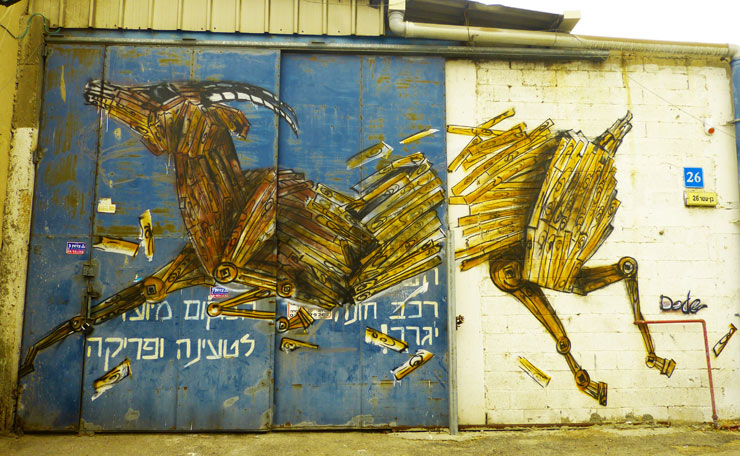
Dede (photo © Yoav Litvin)
Interview with Dede
Conducted, translated and edited by Yoav Litvin
Yoav Litvin: What is the significance of art in the streets?
Dede: For me, street art began as simply a form that was just there. Over time, it gained more and more significance and has become the central and primary form in which I work. Street art is challenging, surprising, dynamic, honest, exposed and always interesting.
Within the urban space I get the most inspiration and drive to create and produce a dialogue with the surroundings and the passersby. On the walls of Tel Aviv, I can initiate democratic and free debates and express my opinions without the meddling or intervention of a curator or gallery. Above all it is a place that enables me to declare my being in the present, and allows me to take part in creating the dynamic urban texture.
Dede (photo © Yoav Litvin)
Yoav Litvin: How are the current forms of street art a sign of our time?
Dede: In the reality in which we live, street art has new life. In the past, pedestrians would walk the streets and be exposed, via the urban bustle, to information and art. Today people spend more time sitting in front of the computer than walking the streets. With the current culture of sharing and social networks, we can feel as though we are wandering the streets without really leaving home; one can be exposed to street art that is currently produced on the other side of the planet!
This opens up new possibilities, spaces, concepts and statements, making the street art medium even more relevant than before. The statements that emerge from the street reflect the status of the population, its pain, suffering, happiness, etcetera. This enables a dialogue with and between the public in the city and the world; artwork that tackles an issue or problem existing in a certain place can raise awareness around the world.
Dede (photo © Yoav Litvin)
Yoav Litvin: How did you become a street artist?
Dede: I have never been able to call myself a street artist. Though my inspiration and energy definitely come from the streets and returns to them, I believe that regarding the artist, the viewer has to decide for him or herself. Art is a concept that is difficult to grasp, almost abstract. It can be described or reviewed in all sorts of ways and everyone has different opinions about it. I create from a place of internal motivation and that makes it hard to explain; I produce regardless of what “art” is.
Yoav Litvin: Do you do studio work as well? What is the difference for you?
Dede: I also work in my studio, mostly preparing for work in the street. In the studio I work on sketches, models and tests that I later develop. Sometimes I accumulate work for a series of works to present in a slightly different manner than I would in the street with a different target audience in mind.
Dede (photo © Yoav Litvin)
Yoav Litvin: What is important for you to highlight in your work as a street artist?
Dede: I guess what’s important for me to highlight in my street art is that there is always an alternative; if there is a pressing issue, whether personal or social, you are allowed to stand up and say what you think about it and in so doing bring the issue to the awareness of the public. Laws should not be complacently accepted, but rigorously reexamined. It is important to be thoughtful, critical and form an educated opinion about them.
Dede (photo © Yoav Litvin)
Yoav Litvin: What does street art in Tel Aviv reflect about the city’s urban life and about its urban civil society? Which is your favorite neighborhood?
Dede: Something about Tel Aviv made me instantaneously feel connected; I love this city and never get tired of it. It offers infinite walls and workspaces, a fast-paced vibe and a lively young crowd that is very admiring, appreciative and supportive. It is a city that does not represent the rest of Israel, but it has become a place characterized by diverse opinions that interact with and affect the rest of the country. Each neighborhood has its own uniqueness; together the neighborhoods produce a varied and interesting city at any time of day, culturally and in many other respects.
Yoav Litvin: Recount a memorable experience that has happened to you while working on a piece in the street.
Dede: Almost every time I go to work in the street I come back with exciting experiences and stories. One day during a quiet morning when I painted in an open parking lot in the Florentine neighborhood, I was on a ladder and a mom and her little boy approached me from behind. The boy asked his mother what I was doing and his mom responded: “What he’s doing is illegal, but this is his way of expressing himself.” This was a very simple statement and made me realize something unique about my way of life.
Dede (photo © Yoav Litvin)
Yoav Litvin: How do you envision the future of street art in general and in Tel Aviv in particular?
Dede: In my opinion it is not possible to predict the future. This art movement plays with and between so many boundaries and stays fresh and always interesting, though, and perhaps because there are many attempts to institutionalize and formalize it or to simply exclude it. Along with its exposure and rapid development, street art is introduced into different parts of the “mainstream”. Some are even commercial even though street art is often illegal and directed against the system. It seems to me that it will take time for the interest in the street art scene to wane.
In my opinion this is just the beginning; street art arrived here in Tel Aviv relatively late, caught on very quickly and is still in its infancy. There are a lot of directions in which it could develop and many artists seek to develop their own styles. Like in any other field we Israelis look at what is happening in the rest of the world and try to bring the unique Israeli context into the mix.
Dede (photo © Yoav Litvin)
Yoav Litvin: Please describe the artistic techniques and materials you favor and why.
Dede: Being a curious person and not very rational, I utilize a variety of techniques. I start thinking of what I want to say or do and where I want to say it and then only how to make it. I work with stencils, pastes, free hand, installations, site-specifics and more. I use paint, spray paint, paper and various industrial materials.
I hope that what eventually echoes out of my work is a path that shows my way of thinking and reasoning with statements that are probably still not completely clear, but will be revealed gradually to both myself and viewer.
Dede (photo © Yoav Litvin)
Dede (photo © Yoav Litvin)
Dede (photo © Yoav Litvin)
Dede (photo © Yoav Litvin)
Dede (photo © Yoav Litvin)
Dede (photo © Yoav Litvin)
Dede. Sket . Task (photo © Yoav Litvin)
Dede (photo © Yoav Litvin)
Dede (photo © Yoav Litvin)
Dede (photo © Yoav Litvin)
Dede’s Info
Website: http://imdede.com/
Facebook: http://www.facebook.com/im.dede
Flickr: http://www.flickr.com/photos/dedeconfidential/
<<>>><><<>BSA<<>>><<<>><><BSA<<>>><><<>BSA<<>>><<<>><><BSA
Please note: All content including images and text are © BrooklynStreetArt.com, unless otherwise noted. We like sharing BSA content for non-commercial purposes as long as you credit the photographer(s) and BSA, include a link to the original article URL and do not remove the photographer’s name from the .jpg file. Otherwise, please refrain from re-posting. Thanks!
<<>>><><<>BSA<<>>><<<>><><BSA<<>>><><<>BSA<<>>><<<>><><BSA
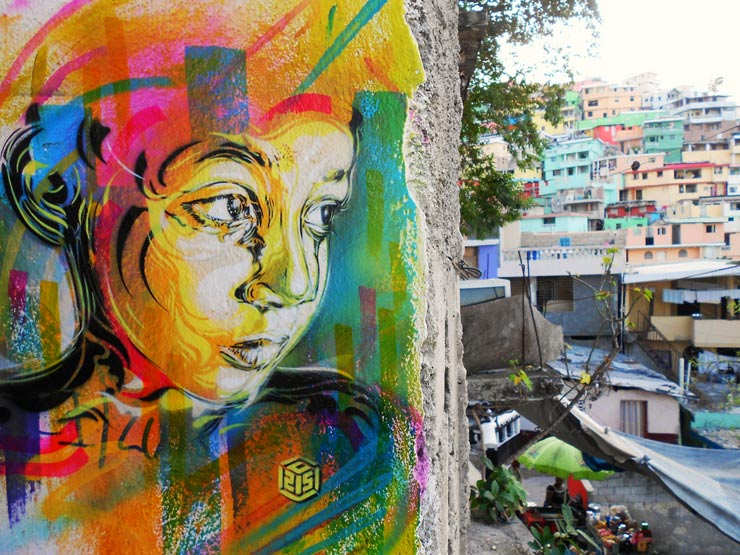
Stencil Street Artist C215 Explores Haiti in Full Color
Parisian Street Artist C215 has been traveling again, this time to Port Au Prince in Haiti, where he drew many curious audiences during the week-long visit to watch him create his evocative stencil portraits on columns, in doorways, along narrow walkways, on rooftops, and in streets.
“It was a very strong experience for me personally. I found it to be kind of a mix between the favelas of São Paulo and the suburbs of Dakar,” says the artist known for casting a light on homeless or otherwise disadvantaged citizens in cities around the world with his very personal stencil portraits.
C215. Port Au Prince, Haiti. April 2013. (photo © C215)
While in Haiti meeting new people and learning as much as he could about the culture on the streets, he also was learning about a small new urban art organization that has goals of one day throwing their own festival with invited international artists. “Aude Hulot of the Kasav organization is guiding me in this anarchic city,” he reports as he carries bags full of aerosol paint through a back alley.
Only a few years ago C215 made his name in the Street Art world with one or two colors, white and black. Often he did his work using only white. With some sort of empathy at hand, he developed an uncanny ability to convey part of the essence of the people he depicted simply through a quickly sprayed stencil on a doorway, or on a dumpster. That sort of honesty in depiction, not shrouded by edifice, made his spare figures almost jump from the mottled and rusted surfaces they appeared on. Since he first began there have been many who have observed that his work inspired a number of new Street Artist – each trying their hand at cutting and spraying portraits. It’s not a bad legacy to tell the truth, but you can sometimes guess that the imitation isn’t always interpreted as flattery.
C215. Port Au Prince, Haiti. April 2013. (photo © Viktor Gjengaar)
These days C215 is making some wildly varicolored departures from the single hue stencil that was once his signature. As he tells us in the interview below, a severe illness a few years ago caused his stark and haunting monochromatic images to suddenly become flooded with life, and without warning they became ebullient, even fantastic, in their audacious color combinations. Looking at the wide range of people he has just created on these walls in Haiti, you know that C215 is again setting a standard with his ability to communicate personality, emotion, ease, rage, fear, and a true humanity on the street.
C215. Port Au Prince, Haiti. April 2013. (photo © C215)
Brooklyn Street Art: How has your experience been in Haiti and what brought you here?
C215: A young woman living in Haiti, Aude Hulot, came to visit me in my studio one day in Paris and during her visit she asked me to come to Haiti to paint portraits in the streets of Port au Prince. She said she was part of a local arts association, Kasav and their goal is to promote urban art in the city – perhaps eventually to create a festival that attracts street artists to their city.
I was interested in experiencing and learning about the dramatic living situation of people in Port au Prince, and to see what has happened in the three years since the earthquake. Because I did not know if I would find a potentially dangerous environment or not, my good friend Viktor Gjengaar from Norway came along – he also helped to document the trip properly with photos and video.
C215. Port Au Prince, Haiti. April 2013. (photo © C215)
Brooklyn Street Art: Can you talk about how you prepared for the trip with your art materials.
C215: I came with a whole collection of Caribbean portraits, a few hummingbirds and tropical flowers, so that the local people could appreciate my art with local subjects. They all understood that way that what I was painting was a clear tribute to their culture, and not simply a Western marking on their walls.
Brooklyn Street Art: When you are selecting individuals for their portrait, what qualities are you looking for?
C215: I simply need to get inspired. I’m not looking for famous people; Instead I look for anonymous ones who anyone can identify with. I learned that it was important in Haiti that no portrait could be understood as a political or a religious message – to avoid possible arguments or controversy. Local citizens were also paying attention to my work to insure that none of the persons whom I painted was dead, because of a concern about the ghost’s spirits. This is part of a prevalent belief in Voodooism that is very strong there.
C215. Port Au Prince, Haiti. April 2013. (photo © Viktor Gjengaar)
Brooklyn Street Art: You could simply reprise one of your earlier stencils from other cities on the street here. Why do you make new ones for new locations?
C215: I mixed up old and new ones, but all them were fitting with the island spirit. I did cut two new portraits based on anthropological studies from the very early nineteenth century; the portraits were of a couple to be precise. As a way to evoke the slavery period I painted them next to bars. Haitian culture has deep memories of slavery and I wanted to pay a tribute to this sad memory.
C215. Port Au Prince, Haiti. April 2013. (photo © C215)
Brooklyn Street Art: Can you talk about the portrait of the kid with the gun in his hand?
C215: This portrait is based on an image by the famous photographer, Steve McCurry. I painted it in one of the wealthiest districts of Port au Prince as a way to evoke the economical and physical violence on the island. I hope it might also draw attention to the reality of street kids who are living in Port au Prince.
C215. Port Au Prince, Haiti. April 2013. (photo © C215)
Brooklyn Street Art: You have spoken before about your concept of your work in the street as community service. Do you feel that you have been providing a service to part of the community here?
C215: I participated in a fundraiser for Haiti in 2010 with Brooklynite gallery but I thought that going to paint by myself in the slums of Port au Prince was rather a social, if not political act. As time has passed I sadly see that nowadays street art is less and less dedicated to the “street people” and it is more often created for the possible collectors.
There are no street art collectors in Haiti, so I think that even though my work is represented by the wealthy Opera Gallery I would like to go paint in one of the 10 poorest countries of the world, and in some way this is a kind of a Community Service. Everybody around me was speaking, before my departure and during my stay, about the risks I was taking by going to paint in a city unfortunately famous for tourist’s kidnappings and murders.
I experienced the city as a street painter and nothing else: I stayed there one week, painting in almost all districts and especially the “red zone”, and I can say that nothing happened and that I felt no threat. So without offering too quick of a conclusion about the island, if Haitians are absolutely poor, I can personally say they like art and respect artists. I felt everywhere I was welcome and my art got a very good reception.
C215. Port Au Prince, Haiti. April 2013. (photo © C215)
Brooklyn Street Art: For many people, one mark of a successful street artist is when they pick the right location for their piece, and the context it appears in. What helps you decide where a piece should be?
C215: Instinct, experience, and the vision I have of the final result before beginning to paint. It is somewhere very technical. I am not looking for the best place to advertise, moreover that I usually paint very small portraits to stay discrete. I am looking for the best result.
Brooklyn Street Art: Your color palette has become so vibrant and full of color in the last couple of years. How has the experience been to using so much color?
C215: Colors became very strong in my works in 2009 after I caught meningitis in Morocco. I lied in complete darkness for one month and when dreaming I had the vision of portraits painted exclusively with very bright colors. I discovered the way to create the images in my dreams and this new palette has had an impact in the streets, making my portraits very eye-catching to people. Using all this color also means I’m taking a greater risk of getting caught that, since it takes longer to paint with many colors than a quick stencil in black or white. I enjoy adrenaline. It was a very good way to turn my works more singular. Now I go painting outside with several cans, but also acrylics, inks and varnishes.
C215. Port Au Prince, Haiti. April 2013. (photo © Viktor Gjengaar)
Also I am using color because I get very quickly bored of repeating the same process, the same technique … I know that many artists on the street like to repeat the same kind of work all their life long but this process could not fit with my personality. I have no idea what I will be painting in the next five years, or even if I will be continuing to paint.
Brooklyn Street Art: Has your line become more relaxed in recent years? It looks like it has a little more fluidity, perhaps more of a feeling of motion.
C215: It is a natural evolution. I pay a little less attention to realistic details and a little more to style. Colors helped me to go into subtle lining since my work is now less based on contrast and sketch effects. Many stencil artists work now in white or black and white in the style I had from 2007 to 2009, working on the same kind of subjects like old people, homeless or sad kids – from Portugal to Iran. So I am happy that this new colored style has helped me to create a distance from what is now a kind of “stencil school” or a global movement. Maybe one day I will come back to white stencils: I like to contradict myself.
C215. Port Au Prince, Haiti. April 2013. (photo © C215)
Brooklyn Street Art: When we think of the artist Gaugin and the impact that the colors of Tahiti had on his painting, do you think the climate and culture of Haiti influenced your choices of colors?
C215: When I was looking at pictures of the city during my research I was impressed by the vivid palette that Haitians use to decorate shops and buses; Art is almost everywhere in the city. I decided to blend in with the scene by using the same colors that I found in the city. Gauguin was looking for the “good savages” in the Pacific islands, but my research is different: I perfectly know that there are no “savages” anymore in this world, only human beings who are equal to me, but from different cultures.
C215. Port Au Prince, Haiti. April 2013. (photo © C215)
Brooklyn Street Art: You had an audience for many of these pieces while you were putting them up. Is it difficult to do the work while people are watching and joking and conferring and talking?
C215: I painted more than fifteen pieces in seven days and every piece took me approximately 30 or 40 minutes to complete. Every time a little crowd gathered to watch what I was painting and I tried to stay focused on my job. When finished, I would speak with one of the people watching so that the others could get an explanation regarding my activity.
Luckily for me Aude Hulot from Kasav always helped to explain to people in their own languages what was the meaning of my work in Port au Prince. I encourage artists who are interested in going to paint there to contact the Kasav association and I am sure they will find them to be a very great help. (http://www.facebook.com/ArtStreetVizyon).
C215. Port Au Prince, Haiti. April 2013. (photo © C215)
C215. Port Au Prince, Haiti. April 2013. (photo © C215)
C215. Port Au Prince, Haiti. April 2013. (photo © Viktor Gjengaar)
C215. Port Au Prince, Haiti. April 2013. (photo © C215)
C215. Port Au Prince, Haiti. April 2013. (photo © C215)
<<>>><><<>BSA<<>>><<<>><><BSA<<>>><><<>BSA<<>>><<<>><><BSA
Please note: All content including images and text are © BrooklynStreetArt.com, unless otherwise noted. We like sharing BSA content for non-commercial purposes as long as you credit the photographer(s) and BSA, include a link to the original article URL and do not remove the photographer’s name from the .jpg file. Otherwise, please refrain from re-posting. Thanks!
<<>>><><<>BSA<<>>><<<>><><BSA<<>>><><<>BSA<<>>><<<>><><BSA
This article also appears on the Huffington Post
BC Gallery Presents: Inaugural Group Exhibition (Berlin, Germany)
Bumblebee
Interesni Kazki
Inti
Jaz
M-City
Moneyless
Sixeart
Sowat
Stinkfish
Grand Opening 26/Apr/13, 18H
Located in the center of Berlin’s culture magnet Friedrichshain, BC Gallery has its headquarters in a brand new top-of-the-line gallery space at Libauer Strasse and a breathtaking off-location on the famed RAW strip .
The grand inaugural gallery show will feature works by Bumblebee, Interesni Kazki, Inti, Jaz, M-City, Moneyless, Sixeart, Stinkfish and the calligraphy French master Sowat, who just finished an impressive work on the gallery floor.
BC Gallery: Libauer Str. 14, 10245 Berlin . Friday April 26th at 6pm
Artifex Gallery Presents: Locatelli Steve Solo Show (Antwerp, Belgium)
Locatelli Steve (Belgium)
Vernissage: 30 November @ 19h
Exhibition: from 1 December till 26 January
Artifex Gallery Presents: Orticanoodles Solo Show (Antwerp, Belgium)
Orticanoodles (Italy)
Vernissage: 2 November @ 19h
Exhibition: from 3 November till 24 November
 BROOKLYN STREET ART LOVES YOU MORE EVERY DAY
BROOKLYN STREET ART LOVES YOU MORE EVERY DAY